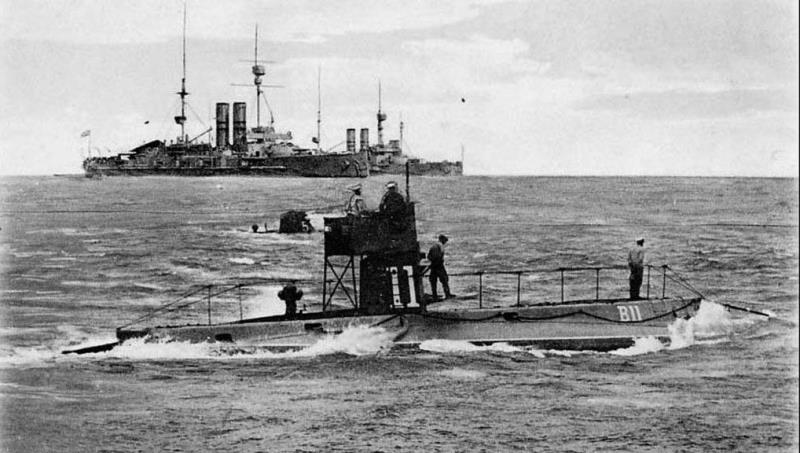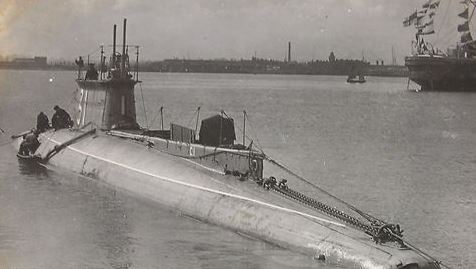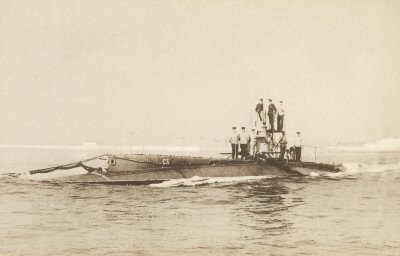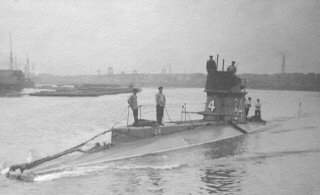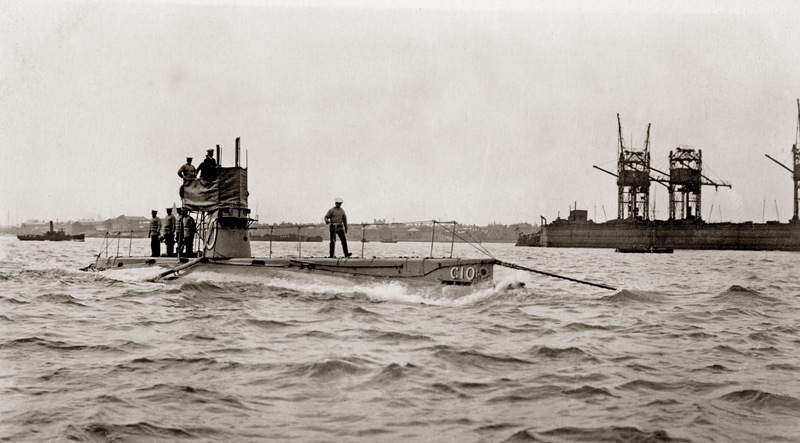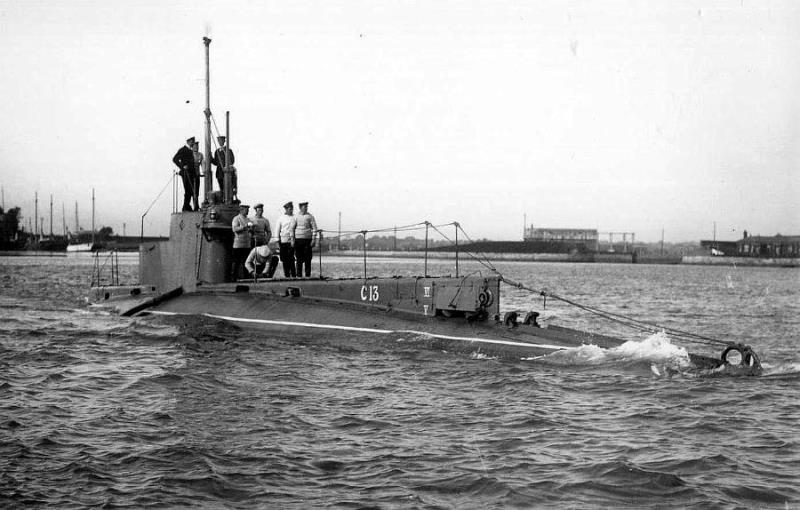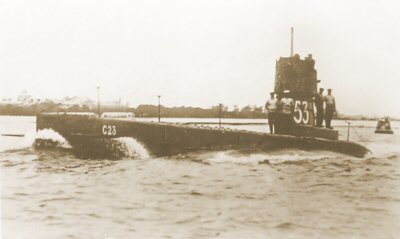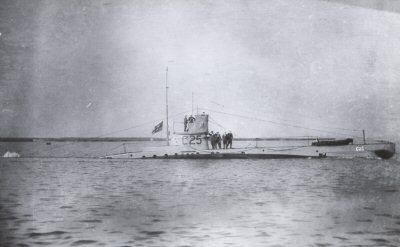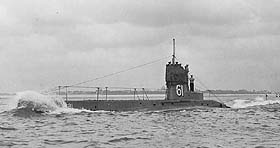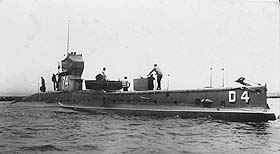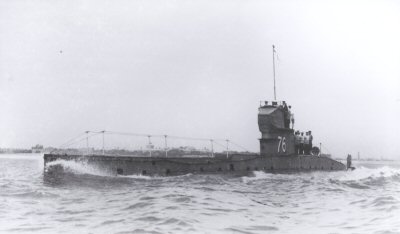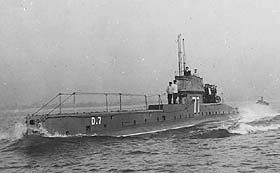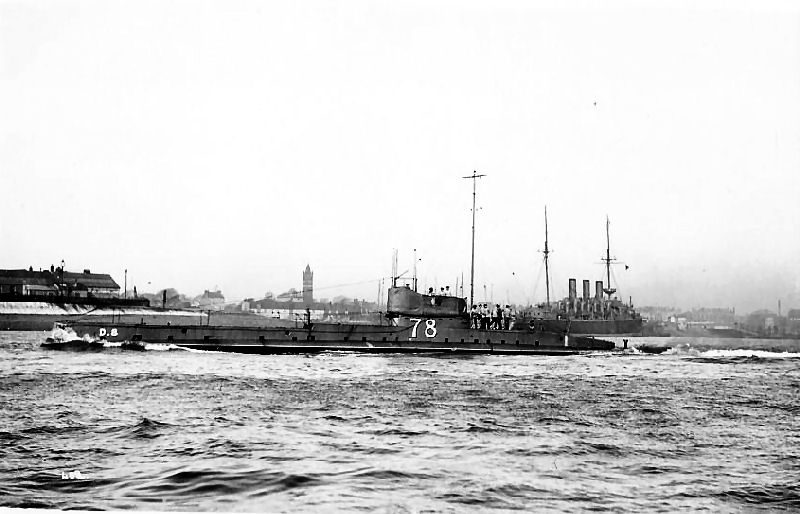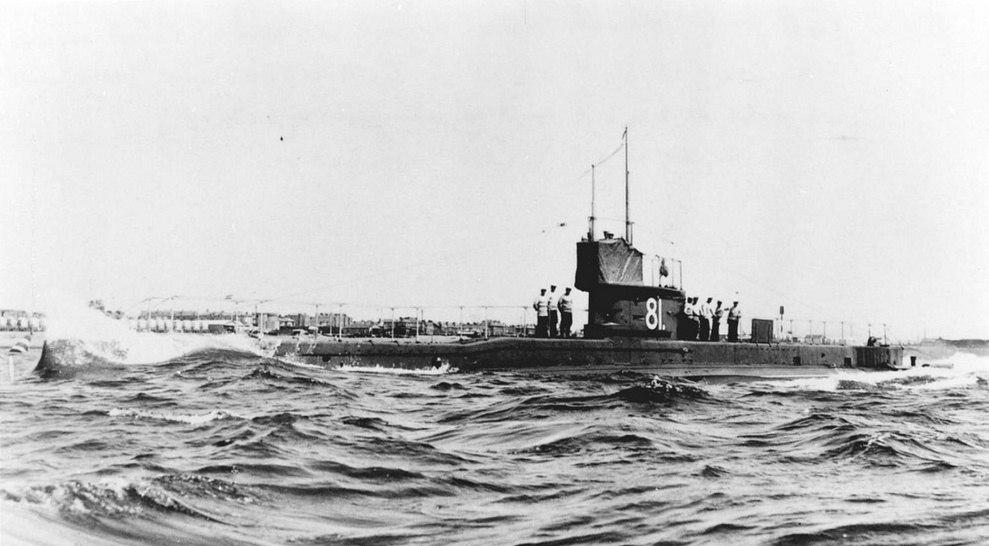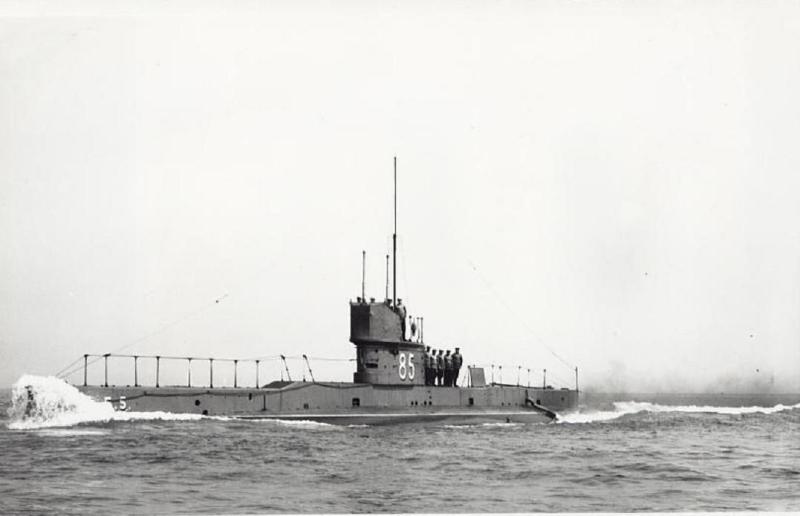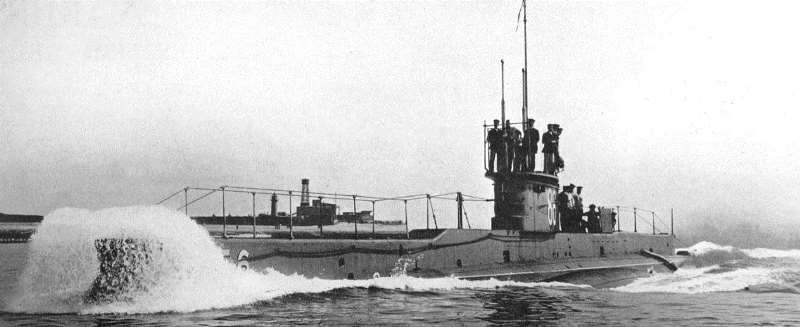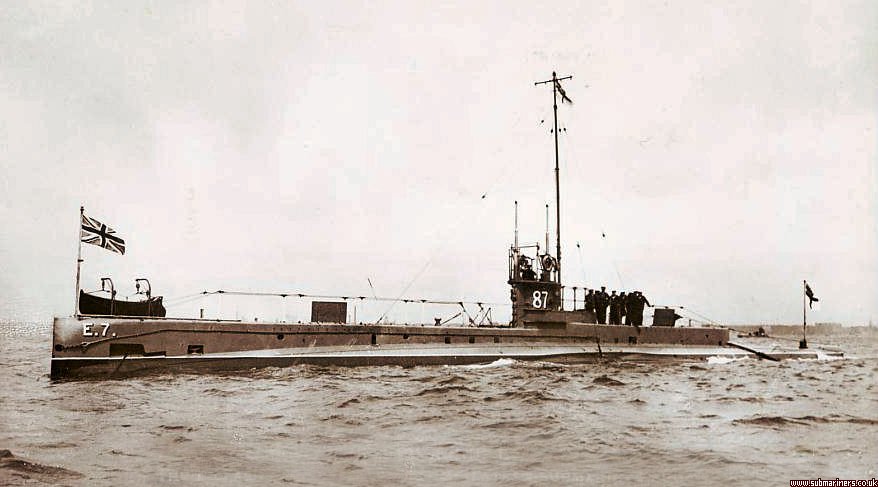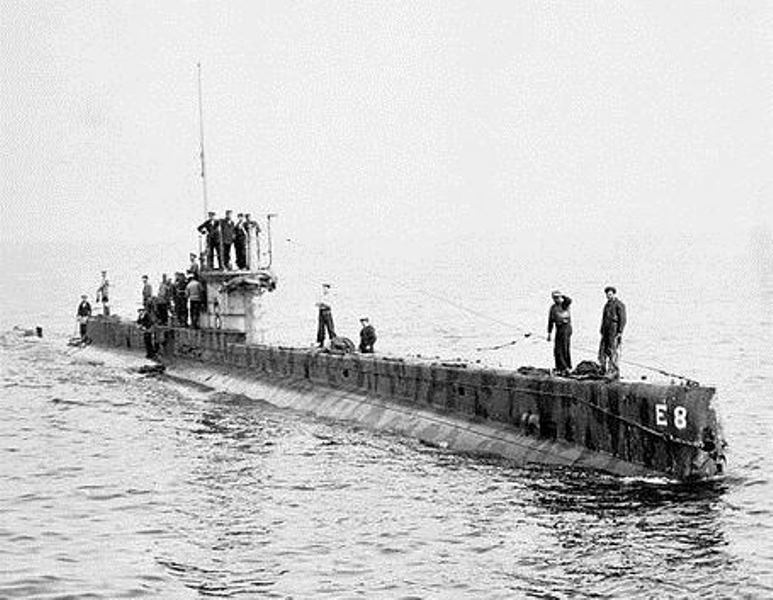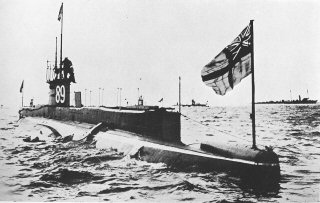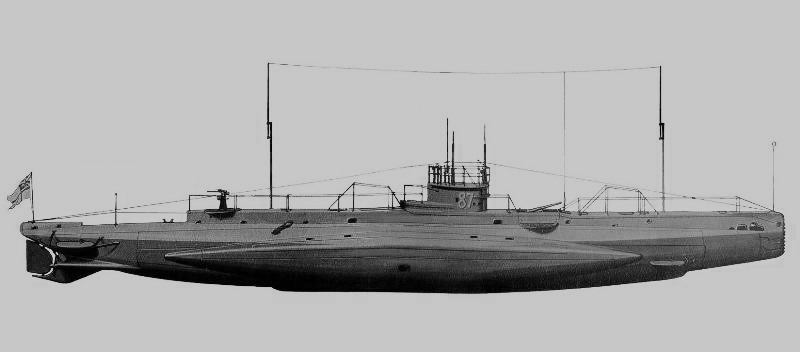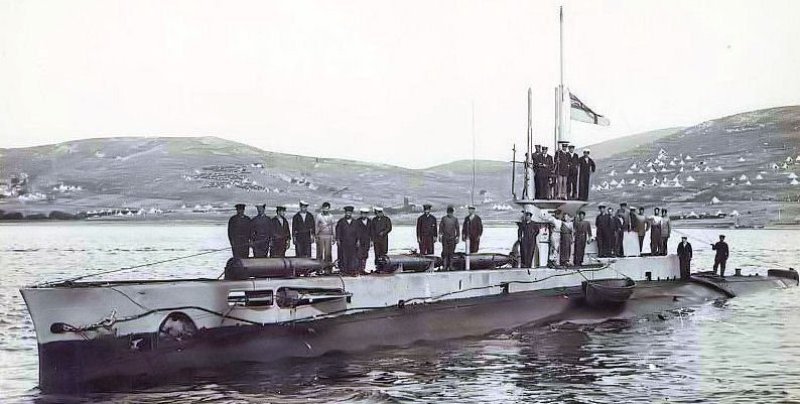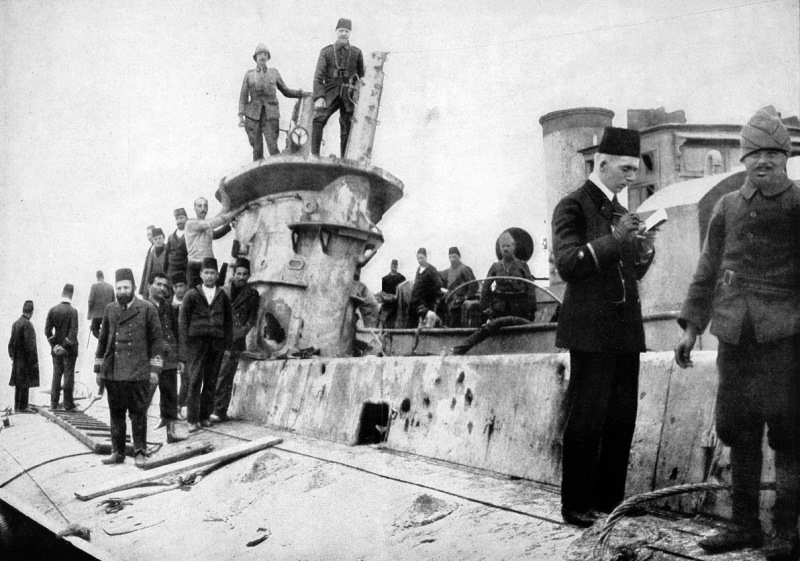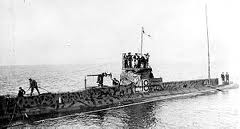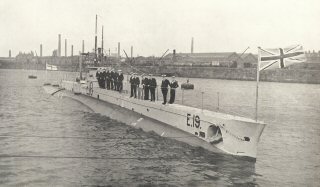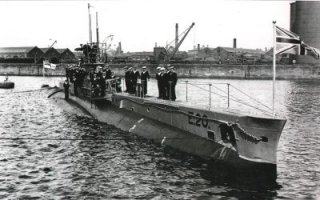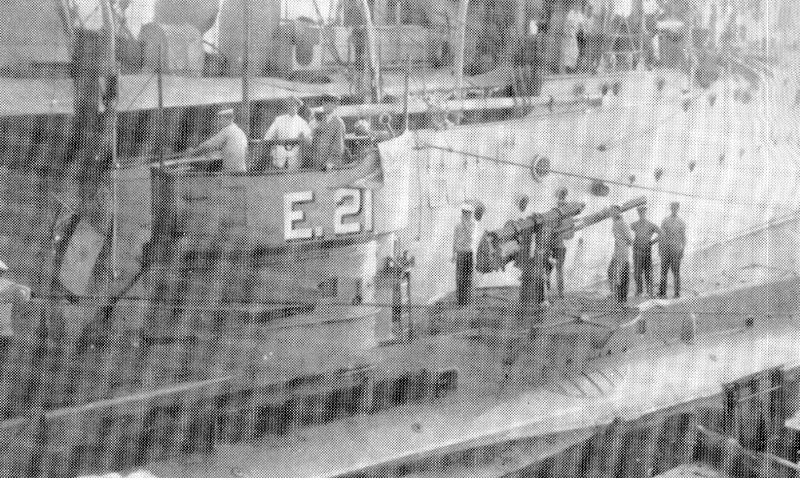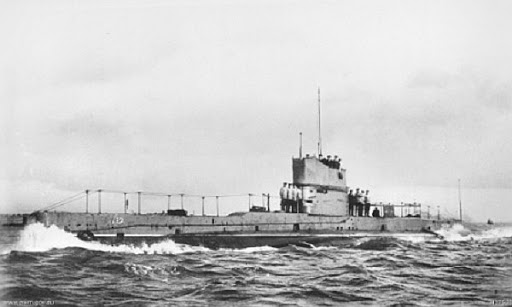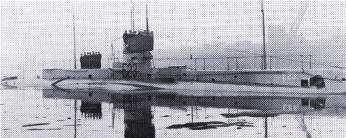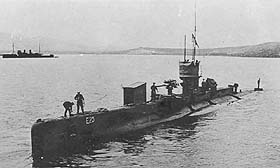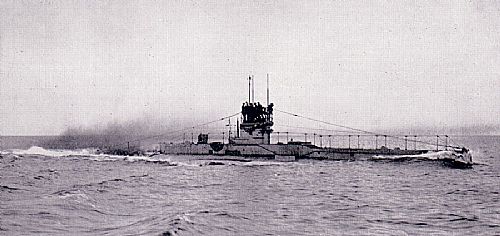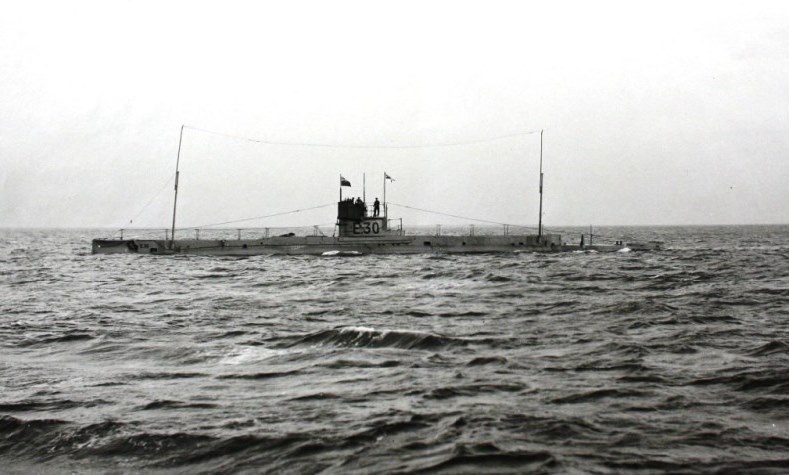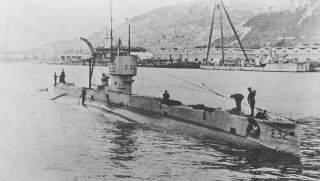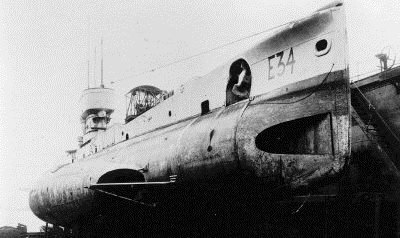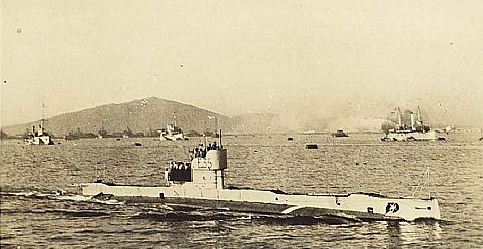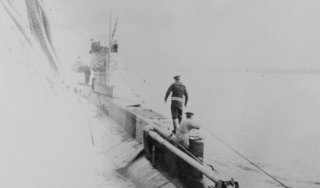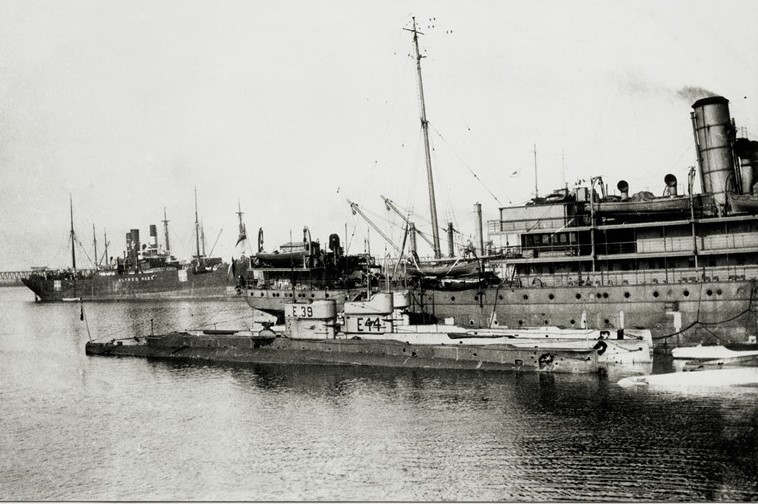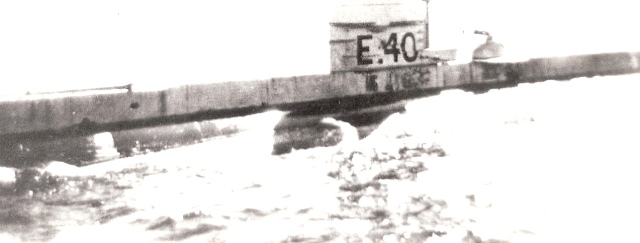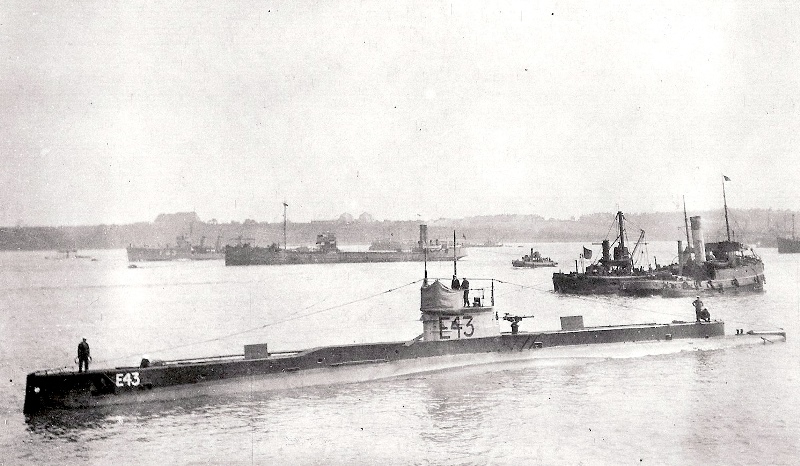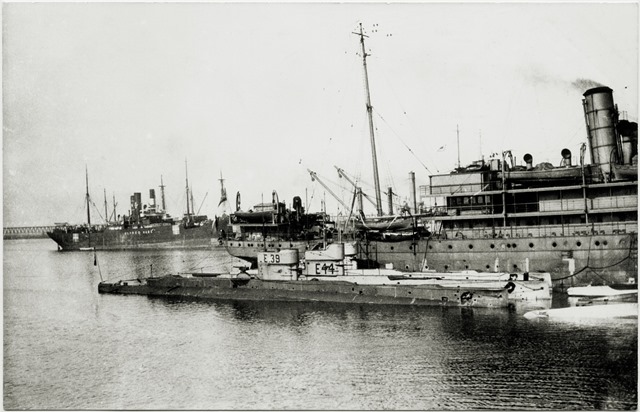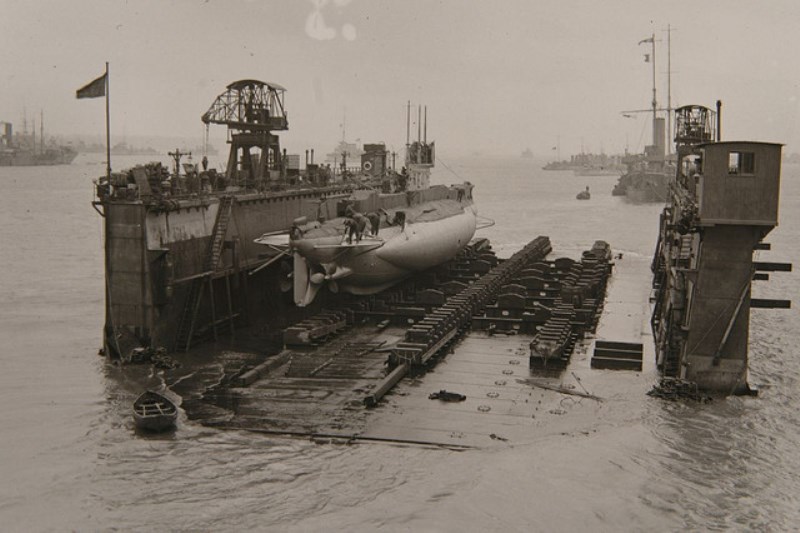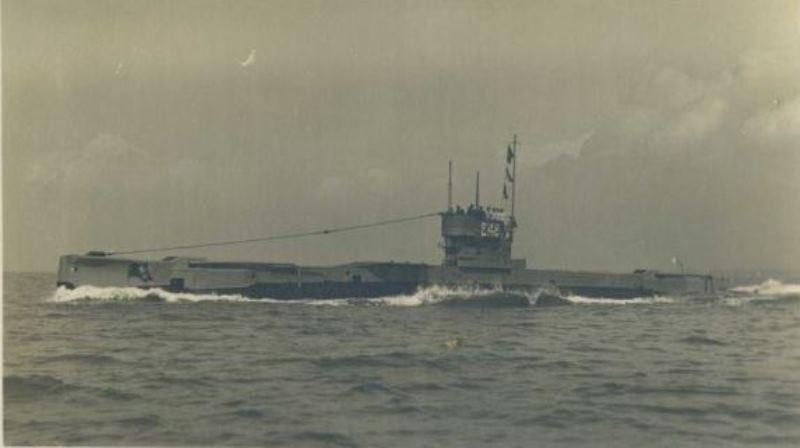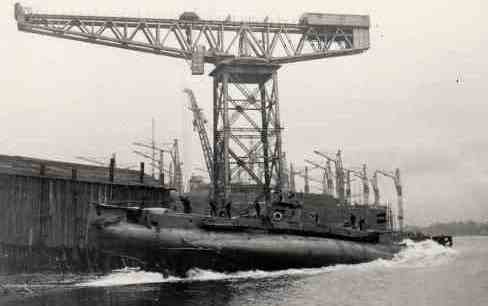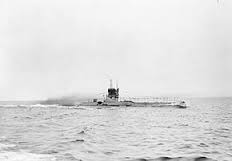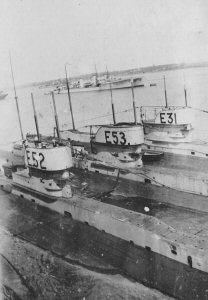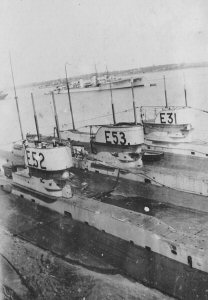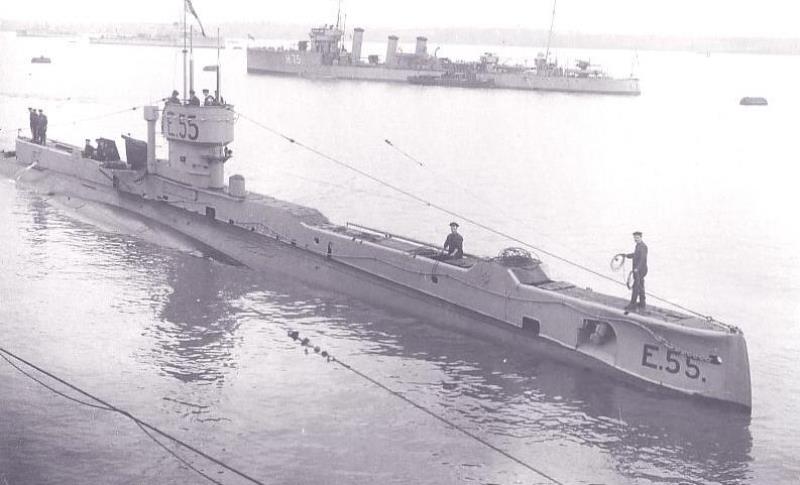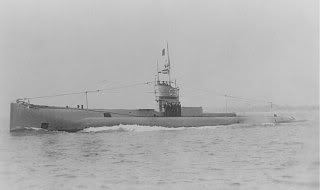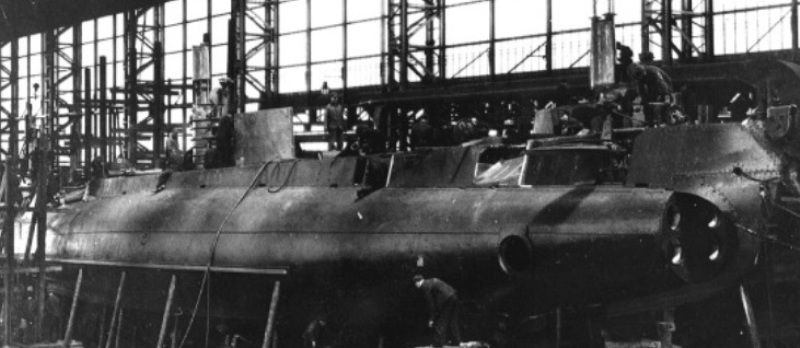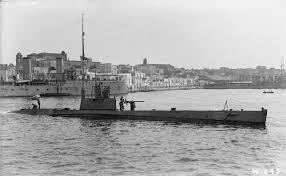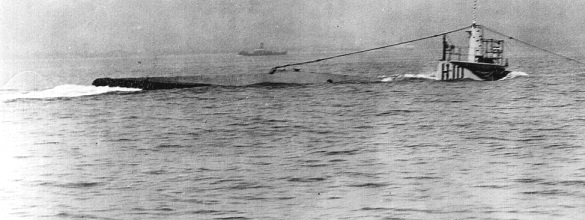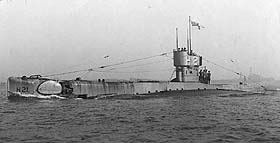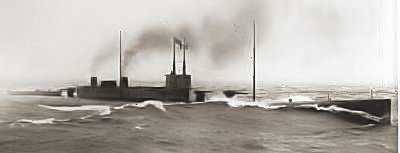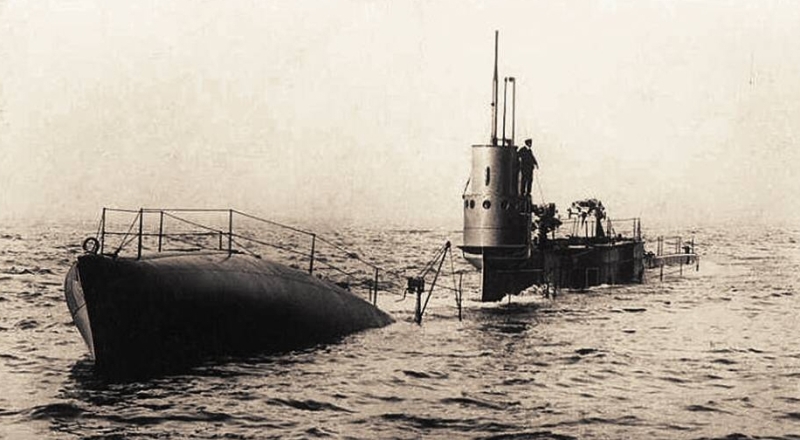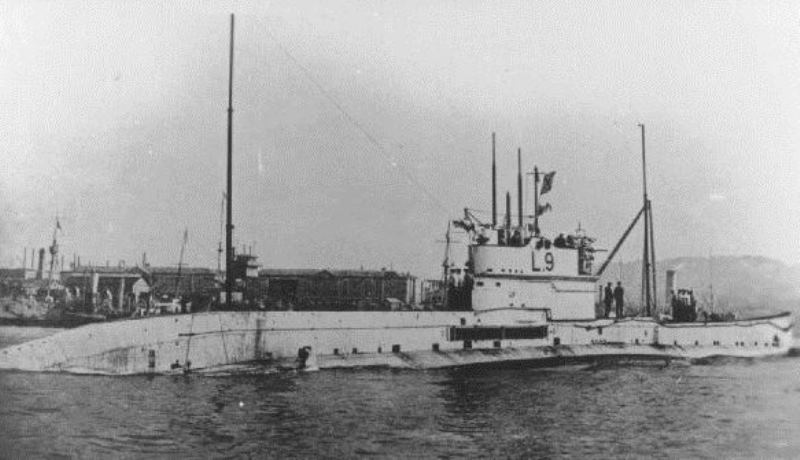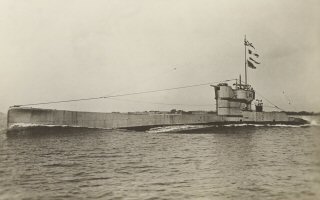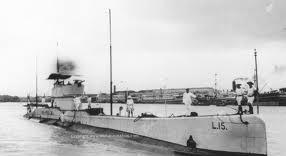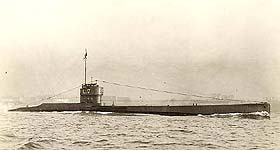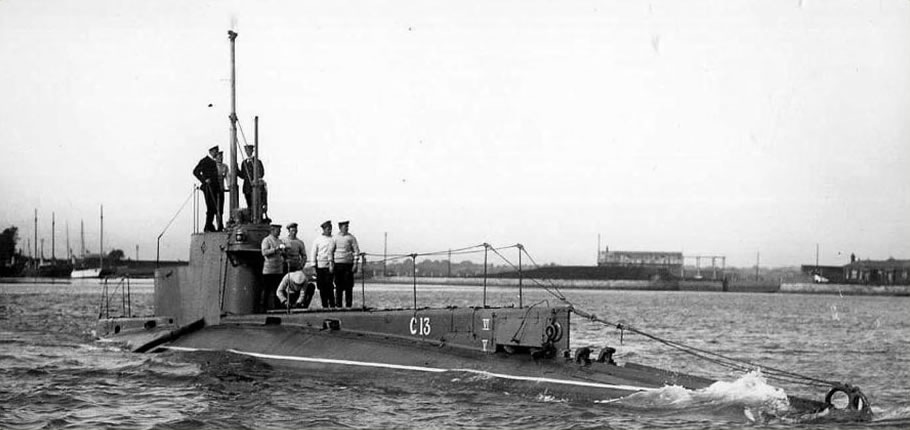
Submarines World War 1
World War I 1914-1918
Submarines were very different from any other kind of warship. For many this was part of the attraction. Even without the demands of war, the submariner’s mettle was being tested the moment he set foot aboard. The technical complexity of the submarine was irresistible for some while for others it was the attraction of the close-knit small ship family. Extra pay seems to have played only a minor part in the submarine sailor’s considerations. As a weapon of war the World War One submarines were well suited to their task. Inexpensive to build and manned by small crews they required a minimum of support and possessed excellent endurance. Properly handled they were fully capable of destroying the largest mercantile vessel or the most powerful warship afloat. There is always a price to be paid for challenging the sea, and the enemy. Unlike the majority of marine accidents, or even wartime engagements, when a submarine was destroyed she almost always took her entire company with her. World War one proved the military value of the submarine to both sides involved in the conflict. Various operations involving the boats demonstrated their ability to enter and operate effectively in waters that were inaccessible to surface ships. In turn, submarines were also recognised as having the potential to deny enemy shipping the freedom to go wherever it wanted. Although British submarines formed a very small part of the Royal Navy overall, Britain possessed the world’s largest submarine service and they were among the first vessel put to sea when war broke out in 1914. Under the terms of the armistice signed by Germany, it was required to surrender its submarines to Britain. On 21 November 1918, the first batch of 20 submarines made their way across the North Sea to the British coast. There, 35 miles of the coast of Essex, they were met by a small flotilla of British warships commanded by Rear Admiral Sir Reginald Tyrwhitt. They were escorted towards the Port of Harwich, and before entering the port, British seaman boarded and took control of the submarines before taking them into the harbour. The German crews were taken back to their own country in transports. The Times newspaper reported that there was little ceremony and there was no jubilation or scenes of cheering when the White Ensign was raised over the conning tower of the vessels. In the following days, 122 submarines and associated craft of the fleet were taken into Harwich.
B Class 1903 – 1906
The B Class Submarines built by Vickers, were similar to the A class with the main difference being the deck casing which was improved for surface performance. Hydroplanes were also fitted for the first time to give it better stability when submerged. Displacement: 287 tons on the surface and 316 tons submerged. Speed, surfaced 12 knots, and 6 knots submerged. Range: 1,000 nautical miles at 8.75 knots on the surface. Compliment: 15 Armament: two – 18 inch Torpedo tubes in the bow and carried 4 torpedoes.
HMS B7
- Launched: 30/11/1905
- Completed. 27/03/1906
- Builder. Vickers
- Length 142 ft.
- Diving Depth. 100 ft.
- Speed. 13.5 knots
- Complement. 15
- Fate. Sold 31/10/1919
B7 was built at Vickers, Barrow-in-Furness, launched 30 November 1905 and completed 27 March 1906. deployed to the Mediterranean soon after the outbreak of World War I. In 1917 the Italian Navy converted B7 into to surface patrol boat S7 to serve in the Adriatic. B7 was sold on 31 October 191 in Malta.
HMS B8
- Laid Down.
- Launched: 23/01/1906
- Completed. 10/04/1906
- Builder. Vickers
- Build Group. B
- Length 142 ft.
- Diving Depth. 100 ft.
- Speed. 13.5 knots
- Complement. 15
- Fate. Sold 31/10/1919
B8 was built at Vickers, Barrow-in-Furness, launched 23 January 1906 and completed 10 April 1906. B8 was deployed to the Mediterranean soon after the outbreak of World War I. Due to the lack of spare parts this group of submarines was not used after September 1915. In 1917 the Italian Navy converted B8 into to surface patrol boat S8 to serve in the Adriatic. B8 was sold on 31 October 1919 in Malta.
HMS B10
- Laid Down.
- Launched: 23/03/1916
- Completed. 28/04/1906
- Builder. Vickers
- Build Group. B
- Length. 142 ft.
- Diving Depth. 100 ft.
- Speed. 13.5 knots
- Complement. 15
- Fate. Sunk 09/08/1916
B10 was built at Vickers, Barrow-in-Furness, launched 23 March 1906 and completed 28 April 1906. B10 was the first submarine to be sunk by air attack in an Austrian air raid on 9/10 August 1910. B10 was docked for repairs but the damage was compounded by the activities of an Italian dockyard welder who began Work with his torch next to one of the submarines petrol tanks. B10 was Surveyed and considered not fit for repair. She was sold locally for breaking up.
HMS B11
- Laid Down.
- Launched: 24/02/1906
- Completed. 11/07/1906
- Builder. Vickers
- Build Group. B
- Length. 142 ft
- Diving Depth. 100 ft
- Speed. 13.5 knots
- Complement. 15
- Fate. Scrapped 1919
B11 was built by Vickers & Company, Barrow and launched on the 24 February 1906. Lieutenant Holbrook took the B11 up the Dardanelles, probably the most heavily defended waterway in the world at the time. B11 was a small (300 ton), under-powered (225hp electric motor) and obsolete boat dating back to 1905 and the early days of submarine development. Despite the treacherous current in the Straits. Holbrook successfully got through a minefield to torpedo the Turkish battleship Messudiyeh. he then managed to return safely down the Dardanelles, despite coming under fire from shore batteries and enemy torpedo boats. B11 had been submerged for no less than nine hours, a remarkable achievement in such a primitive craft. Holbrook was awarded the Submarine Services first Victoria Cross.
C Class 1905 – 1922
C Class submarines where designed for Coastal duties and was the first major production for the Royal Navy; these submarines were considered for harbour defence and an alternative to minefields. Displacement: 288 tons surfaced and 318 tons submerged. Speed: 13 knots on the surface and 7.5 knots submerged. Range: 1000 nautical miles on the surface at 8.75 knots
HMS C1
- Laid Down. 13/11/1905
- Launched. 10/07/1906
- Completed. 30/10/1906
- Builder. Vickers
- Build Group. C
- Length 142 ft.
- Diving Depth. 100 ft.
- Speed. 13 Knots
- Complement. 16
- Fate. Scrapped 1920
C1 was built by Vickers, Barrow. She was laid down on 13 November 1905, launched 10 July 1906 and was commissioned on 30 October 1906. C1 was converted to a surface patrol boat and renamed S8 fo Adriatic service. On 23 April 1918 she was packed with dynamite to be blown u at Zeebrugge Mole. However, this did not happen. C1 was sold 22 October 1920 to Stanlee, and resold 14 November 1921.
HMS C2
- Laid Down. 13/11/1905
- Launched. 10/07/1906
- Completed. 26/11/1906
- Builder. Vickers
- Build Group. C
- Length 142 ft.
- Diving Depth. 100 ft.
- Speed. 13 Knots
- Complement. 16
- Fate. Scrapped 8/10/1920
C2 was laid down on the 13th of November 1905, launched on the 10th of July 1906, and commissioned on the 20th November the same year.
10/04/1914. Submarines Narrow Escape. It has just become known that an alarming mishap befell submarine C2 off Harwich last Thursday. The vessel had successfully gone through the exercise of attacking the Sunk lightship, and when rising to the surface her commander, Lieut. Shove found that he was immediately beneath the parent ship, H.M.S. Hebe. He attempted to manoeuvre between the Hebe and the Fairy, but the propeller of the Hebe caught the submarine and tore away the periscope and part of the conning-tower. The impact threw every man of the crew, fourteen in number, down and nearly all received bruises and abrasions. Only the coolness of the officers and men averted serious consequences.
In 1916 she was deployed with the 5th Flotilla at Sheerness, attached to Hms Thames and commanded by Lieutenant Commander Herbert Shove. She was sold on the 8th of October 1920, for scrapping by Maden & Mckee, Porthcawl.
HMS C3
- Laid Down. 25/11/1905
- Launched. 03/10/1906
- Completed. 23/02/1907
- Builder. Vickers
- Build Group. C
- Length. 142 ft.
- Diving Depth. 100 ft.
- Speed. 13 Knots
- Complement. 16
- Fate. Blown Up 24/04/1918
C3 was built by Armstrong Vickers and was launched on the 3rd October 1906. By 1917 German submarines had wreaked havoc on British shipping, which threatened Britain’s very ability to continue to fight. It was decided that the best way to stop the carnage was to block the gateways by which the U-boats entered the North Sea, namely Ostend and Zeebrugge. A plan was devised for an assault on the harbours, a key part of which entailed the partial destruction of the viaduct connecting the Zeebrugge Mole to the mainland to prevent reinforcements being rushed from nearby Bruges. This part of the assault required the use of submarines, which were to be packed with explosives, and rammed against the viaduct; the antiquated C1 and C3 were selected for the task.
HMS C4
- Laid Down. 25/11/1905
- Launched. 18/10/1906
- Completed. 13/03/1907
- Builder. Vickers
- Build Group. C
- Length 142 ft.
- Diving Depth. 100 ft.
- Speed. 13 Knots
- Complement. 16
- Fate. Scrapped 28/02/1922
C4 was built by Armstrong Vickers (Yard No.339) laid down on the 25th of November 1905, launched on the 18th of October 1906, and commissioned on the 13th of March 1907.In April 1909, along with the other submarines of the Class, C4 was allocated to the 3rd Division of the Home Fleet at Sheerness, and in September 1914, under the command of Lieutenant Alfred Edward Whitehouse, she formed part of the 5th Submarine Flotilla along with C1, C2, C3, C5, C6, and.HMS Thames. The following year, on the 27th of March, C4 was on the surface charging her batteries just off Beachy Head. She again sighted a U-boat and Musters let off two torpedoes which again were assumed to have missed as the German submarine dived out of sight. The Log later revealed that the torpedoes had hit the U-boat just under the conning tower, but again had failed to explode. C4 was the only C class submarine not to be scrapped at the end of the war; instead she was used for trial and sold on 28 February 1922.
HMS C5

C5
- Laid Down. 24/11/1905
- Launched. 20/08/1906
- Completed. 13/03/1907
- Builder. Vickers
- Build Group. C
- Length 142 ft.
- Diving Depth. 100 ft.
- Speed. 13 Knots
- Complement. 16
- Fate. Scrapped 31/10/1919
C5 was built by Armstrong Vickers and was laid down on the 24th of November 1905, launched on the 20th of August 1906, and commissioned on the 15th of December the same year. In April 1909, along with the other submarines of the Group, C5 was allocated to the 3rd Division of the Home Fleet and in September 1914, she formed part of the 5th Submarine Flotilla attached to HMS Thames. C5 was sold at Malta and scrapped on the 31st October 1919.
HMS C6
- Launched. 20/08/1906
- Completed. 21/01/1907
- Builder. Vickers
- Length 142 ft.
- Diving Depth. 100 ft.
- Speed. 13 Knots
- Complement. 16
- Fate. Scrapped 20/11/1919
C6 was built by Armstrong Vickers and was laid down on the 24th of November 1905, launched on the 20th of August 1906, and commissioned on the 21st of January 1907. In 1918 she was attached to HMS Vernon at Portsmouth for ant-submarine warfare training. C6 was sold for scrapping on the 20th of November 1919
HMS C7
- Laid Down. 09/12/1905
- Launched. 15/02/1907
- Completed. 23/05/1907
- Builder. Vickers
- Build Group. C
- Length 142 ft.
- Diving Depth.100 ft.
- Speed. 13 Knots
- Complement. 16
- Fate. Scrapped 20/12/1919
C7 was built by Armstrong Vickers and launched on the 15th February 1907,With limited endurance and only a ten percent reserve of buoyancy over their surface displacement, they were poor surface vessels, but their spindle shaped hull made for good underwater performance compared to their contemporaries C7 is often mistakenly credited with sinkin UC-68 on 5 April 1917 off the coast of the Netherlands. C7 was sold on 20 December 1919.
HMS C8
- Laid Down. 09/05/1905
- Launched. 15/02/1907
- Completed. 23/05/1907
- Builder. Vickers
- Build Group. C
- Length 142 ft.
- Diving Depth. 100 ft.
- Speed. 13 Knots
- Complement. 16
- Fate. Scrapped 1920
C8 was built by Vickers, Barrow-in-Furness. She was laid down on 9 December 1905 and was commissioned on 23 May 1907. On the 19th of August 1916 the German High Seas Fleet was at last at sea, and the British Grand Fleet had put to sea in an attempt to intercept it. The German Fleet was sighted by the trawler and C8 was duly slipped from her tow to position herself for an attack. Unfortunately Lieutenant Everard could not see anything through his periscope and decided to bring C8 to the surface to ascertain his position. The German Fleet wasn’t where it was supposed to have been but Everard could see smoke in the distance and assumed that it had crossed his path, turned around, and was now approaching him. C8 dived again to position herself for an attack, but was only able to get into a position to attack the last of the cruisers. Everard fired two torpedoes from long distance but no explosions were heard. Sometime later C8 surfaced only to see what he assumed was the German Fleet disappearing into the distance and his trawler way off in the distance, being approached by a destroyer which he assumed was about to attack it. C8 dived once again to get into position to the destroyer. As Everard approached the target he was surprised to see her flashing with her signal lamp C8’s identification number. He surfaced and reported that he had attacked the German Fleet and fired two torpedoes which had missed their target. The destroyers reply came as a shock when Everard was informed that he had attacked the British Grand Fleet and it was just as well that he was a bad shot. On the 22nd of October 1920, C8 was sold to Stanlee for scrapping, but was then re-sold to T. Young on the 14th of November 1921.
HMS C9
- Laid Down. 30/12/1906
- Launched. 03/04/1907
- Completed. 18/06/1907
- Builder. Vickers
- Build Group. C
- Length 142 ft.
- Diving Depth. 100 ft.
- Speed. 13 Knots
- Complement. 16
- Fate. Scrapped 1922
C9 was built by Armstrong Vickers and was launched on the 3rd of April 1907, 31 July 1911 – C9 damaged her bow casting when going into Hartlepool Harbour at night she was refloated at Sheerness after being fitted with a new casting made for her at Barrow and resumed duties with Section III Submarine Flotilla at Harwich. C9 was scrapped in July 1922 by Stanlee, Dover
HMS C10
- Laid Down. 30/01/1906
- Launched. 15/03/1907
- Completed . 13/07/1907
- Builder. Vickers
- Build Group. C
- Length 142 ft.
- Diving Depth. 100 ft.
- Speed. 13Knots
- Complement. 16
- Fate. Scrapped 22/10/1920
C10 was Laid down on the 30th of January 1906 (yard number 343), launched on the 15th of March 1907, and commissioned on the 13th of July the same year. In 1914 C10 was with the 6th Submarine Flotilla, Humber, attached to HMS Bonaventure, and under the command of The Hon. Lieutenant Byron Plantagenet Cary. In 1916 C10 was with the 2nd Flotilla (Tyne), under the command of Lieutenant Ronald Adair Trevor, still attached to Bonaventure. On the 22nd of October 1920, C10 was sold to Stanlee, Dover for scrapping, but then subsequently sold to T. Young, Sunderland on the 14th of November 1921 for final dismantling.
HMS C11
- Laid Down. 06/04/1906
- Launched. 27/05/1907
- Completed. 03/09/1907
- Builder. Vickers
- Build Group. C
- Length 142 ft.
- Diving Depth. 100 ft.
- Speed. 13 Knots
- Complement. 16
- Fate. Sunk 14/07/1909
C11 was built by Vickers, Barrow. She was laid down on 6 April 1906 and was launched on the 27th of May 1907. In the late afternoon of Wednesday the 14th of July 1909, HMS Bonaventure and the eight submarines of the 6th Flotilla left Grimsby on exercise, accompanied by eight torpedo boats. At 23:45 that night, the flotilla and torpedo boats were steaming line ahead at 11 knots, and were 4.5 miles from Happisburgh Light, approximately 20 miles from Cromer. C11 was leading the formation. The vessels were brightly illuminated, but conditions were foggy and deteriorating. Heading in the opposite direction was the 2,823 ton collier, SS Eddystone, under the command of Captain T. Pritchard, homeward bound from the Sea of Azov, The Admiralty had not seen fit to warn Prichard’s ship that the 6th Flotilla was in the area. As Eddystone attempted to cross the line of the flotilla, submarines and torpedo boats swung their helms to avoid collision with the steamer. C11 was struck by Eddystone, whose bows cleaved into the stern of the submarine. C11 was sunk in a collision with the collier Eddystone in the North Sea south of Cromer, Norfolk on the 14 July 1909. There were only three survivors. The wreck was discovered in the late 1990s.
HMS C12
- Laid Down. 27/11/1906
- Launched. 09/09/1907
- Completed. 19/01/1908
- Builder. Vickers
- Build Group. C
- Length. 142 ft.
- Diving Depth. 100 ft.
- Speed. 13 Knots
- Complement. 16
- Fate. Sunk 1918
C12 was built by Vickers, Barrow. She was laid down on 27 November 1906 and was commissioned on 19 January 1908. Following a main motor failure C12 was driven by the tide against a destroyer lying at the Eastern Jetty, Immingham and was holed and sank on the 6th October 1918. She was salvaged and recommissioned. She was sold on 2 February 1920
HMS C13
- Laid Down. 29/11/1906
- Launched. 09/11/1907
- Completed. 19/02/1908
- Builder. Vickers
- Build Group. C
- Length. 142 ft.
- Diving Depth. 100 ft.
- Speed. 13 Knots
- Complement. 16
- Fate. Scrapped 1920
C13 was built by Vickers Armstrong, Barrow, Pennant No. I43 and was laid down on the 29th of November 1906, launched on the 9th of November 1907, and commissioned on the 19th of February 1908 under the command of Lieutenant E. W. Leir. In August 1914 she is listed as being with the 6th Flotilla attached to HMS Bonaventure. and under the command of Lieutenant Commander William J. Foster. In August 1916 she was with the 2nd Flotilla (Tyne), still attached to Bonaventure, and commanded by Lieutenant Martin H. Collier.
HMS C16
- Laid Down. 14/12/1906
- Launched. 19/03/1908
- Completed. 05/06/1908
- Builder. Vickers
- Build Group. C
- Length. 142 ft.
- Diving Depth. 100 ft.
- Speed.13 Knots
- Complement. 16
- Fate. Scrapped 1922
C16 was built by Armstrong Vickers and launched on the 19th March 1908.
During a training exercise, near Harwich in 1917, submarine C16 accidentally struck HMS Melampus during a dummy attack,The damage to the sub’s conning tower resulted in the submarine gradually filling up with water. In an effort to summon help, an attempt was made for the courageous 1st Lt Anderson was later found by salvagers with the following message tied to wrist in a waterproof bag. “We are in 16 feet of water. The way to get us out is to lift the bows by the spectacle and haul us out of the boat through the tubes. H.Boase.”
As carbon dioxide levels rose, the remaining crew the flooded the torpedo department and tried to open a hatch to escape. Unfortunately, a jammed piece of equipment means the hatch could only open ten inches, allowing water in but no-one out. All the crew drowned.
C16 was sold for scrap and the officers and men were buried at Harwich.
HMS C19
- Laid Down. 01/06/1908
- Launched. 20/03/1909
- Completed. 09/11/1909
- Builder. Vickers
- Build Group. C
- Length. 142 ft.
- Diving Depth. 100 ft.
- Speed. 13 Knots
- Complement. 16
- Fate. Scrapped 02/02/1920
C19 was built by Chatham Dockyard and launched on the 20th March 1909, C19 moved to Harwich in 1917 and joined 9th Flotilla and HMS Maidstone. She moved again in 1917, this time to join 3rd Flotilla with HMS Hebe at Immingham and remained there until the end of the Great War.
HMS C23
- Laid Down. 07/02/1908
- Launched. 26/11/1908
- Completed. 05/05/1909
- Builder. Vickers
- Build Group. C
- Length. 142 ft.
- Diving Depth. 100 ft.
- Speed. 13 Knots
- Complement. 16
- Fate. Scrapped 1921
C23 was built by Vickers, Barrow. She was laid down on 7 February 1908 and was commissioned on 5 May 1909. In March 1917 in the North Hinder area C23 came across a shelled Dutch Steamer S/S Amstelstroom, they came alongside and picked up the ships Second mate who was still on board. Amstelstroom was sunk on March 27 by the submarine of the Kaiserliche Marine SMS UB-10.
HMS C25
- Laid Down. 27/02/1908
- Launched. 10/03/1909
- Completed. 28/05/1909
- Builder. Vickers
- Build Group. C
- Length. 142 ft.
- Diving Depth. 100 ft.
- Speed. 13 Knots
- Complement. 16
- Fate. Scrapped 05/12/1921
C25 was Built by Vickers, Barrow. She was laid down on 27 February 1908 and was commissioned on 28 May 1909. C25 was machine-gunned and bombed by a squadron of five German Hansa-Brandenburg seaplanes based at Zeebrugge off Harwich on 6 July 1918, after being caught on the surface. Several rounds killed the commanding officer, Lieut. David C. Bell, and three lookouts on the conning tower. One of the bodies blocked the conning towers hatch so she was unable to dive. The first Lieutenant, Sub-Lieut. Ronald M. Cobb, and two engine room artificers cut off the leg of one of the bodies with a hacksaw to free the hatch. Another two crew members died while trying to close the hatch. The holes in the pressure hull were plugged by clothes and luckily E51 was able to tow C25. The seaplanes, led by Oblt.d.R. Friedrich Christiansen, returned re-armed and ready to attack again, but they were driven off by the arrival of the Acheron class destroyer, HMS Lurcher. C25 was sold on 5 December 1921
HMS C31
- Laid Down. 07/01/1909
- Launched. 02/09/1909
- Completed. 19/11/1909
- Builder. Vickers
- Build Group. C
- Length. 142 ft.
- Diving Depth. Ft.
- Speed. 13 Knots
- Complement. 16
- Fate. Destroyed 1915
C31 was built by Vickers, Barrow for the Royal Navy. She was laid down on 7 January 1909 and was commissioned on 19 November 1909. C31 sailed from Dover to patrol off Zeebrugge. The submarine was due to arrive at Harwich on 7th January, which she failed to do. No further contact was made and a search conducted by the Destroyers Lercher and Firedrake and the Royal Navy Air Service failed to locate the submarine or any survivors.
HMS C33
- Laid Down. 29/03/1909
- Launched. 10/05/1910
- Completed. 13/08/1910
- Builder. Vickers
- Build Group. C
- Length. 142 ft.
- Diving Depth. 100 ft.
- Speed. 13 Knots
- Complement. 16
- Fate. Mined 1915
C33 was built by Chatham Dockyard, Chatham for the Royal Navy. She was laid down on 29 March 1909 and was commissioned on 13 August 1910. In common with her C Class sisters, she represented the last British evolution of the original Holland design. Her low reserve bouyancy meant that she handled poorly on the surface, but her spindled, almost teardrop shape meant that she had good handling characteristics when submerged. The C Class were the last British submarines to have petrol engines, but the first to feature forward hydroplanes. On completion, she displaced 290 tons surfaced and 320 tons dived. She was armed with 2 18″ torpedo tubes and carried a crew of 16 men who lived aboard in primitive conditions, lacking even a proper toilet.At the outbreak of the Great War, she was based in Dover as part of the 4th Submarine Flotilla with HMS Arrogant as Depot Ship. By January 1915, she had moved to Harwich and was employed using the U-Boat Trap tactic. In this, a submarine would be towed submerged behind a bait vessel. When challenged by the U-Boat, the bait vessel would transmit instructions to the submarine, which would slip its tow and attempt to torpedo the German U-Boat. The tactic did meet with some successes (believe it or not).On 4th August 1915, C33 had completed a ‘U-Boat Trap’ patrol with the armed trawler Malta. The two vessels parted company at 20:15 that day and the last contact with the submarine was made by wireless at 21:50. No further contact was made with C33 and despite a search, no wreckage or survivors were found. The Admiralty assumed that C33 was lost to a mine with all hands, as the Germans made no claims regarding her loss.
HMS C34
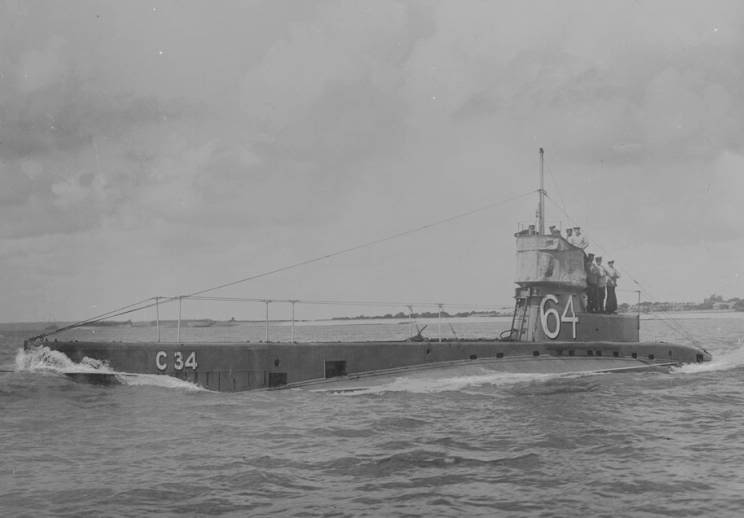
C34
- Laid Down. 29/03/1909
- Launched. 08/06/1910
- Completed. 17/09/1910
- Builder. Vickers
- Build Group. C
- Length. 142 ft.
- Diving Depth. 100 ft.
- Speed.13 Knots
- Complement. 16
- Fate. Torpedoed 21/07/1917
C34 was built by Chatham Dockyard for the Royal Navy. She was laid down on 29 March 1909 and was commissioned on 17 September 1910. in 1915 C34 had moved to Harwich and was employed on ‘U-Boat Trap’ patrols in the North Sea. The U-Boat Trap was an attempt to disrupt U-Boats then causing mayhem in the North Sea. It worked by having a bait vessel, usually an armed trawler, towing a submerged submarine. When challenged by a U-Boat, the trawler would transmit orders to the submarine which would slip its tow and attempt to torpedo the U-Boat. On 24th July 1917, C34 was caught on the surface off Fair Isle in Shetland by U-52 and was sunk by gunfire. There was only one survivor, Leading Rating John Capes, who was rescued by U-52 and spent the rest of the war in a German POW camp.
D Class 1907 – 1919
The D Class, approved by the Admiralty Board in 1906, was designed to overcome, as far as possible, the limitations of the earlier submarine classes. Initial design work was carried out by the Admiralty for the first time on a submarine project, but with the usual procedure for other Admiralty vessels. Between 1907 and 1912, eight of the class were built – six at Barrow and two at Chatham.
HMS D1
- Laid Down. 14/05/1907
- Launched. 16/05/1908
- Completed. 01/09/1909
- Builder. Vickers
- Build Group. D
- Length. 164 ft.
- Diving Depth. 100 ft.
- Speed. 14.5 Knots
- Complement. 25
- Fate. Sunk 23/10/1918
D1 was built by Vickers, Barrow and was launched on 16 May 1908. In 1910, D1 took part in the Annual Manoevures. She torpedoed 2 blue fleet cruisers off Colonsay This showed that the D class could operate a considerable away from their base at Fort Blockhouse. Not long after hostilities began in 1914, the 8th Submarine Flotilla was engaged in action in the North Sea, with the sinking of the German destroyer S126, by Max Horton’s E9 , not far off the German coast at the mouth of the river Ems. With the German High Command wary of the British submarine operations, Commodore Keyes was keen to send submarine patrols even further into enemy inshore waters. Later in October 1914, a special reconnaissance operation was mounted with D1, under the command of Archibald Cochrane, and D3, commanded by Edward Courtney Boyle. They left Harwich and penetrated further east than any other previous patrol to search for information on German shipping movements in the Skagerrak. The valuable information obtained was instrumental in the plans, and subsequent sorties of British submarines in the Baltic.
HMS D2
- Laid Down. 10/07/1909
- Launched. 25/05/1910
- Completed. 29/03/1911
- Builder. Vickers
- Build Group. D
- Length. 164 ft.
- Diving Depth. 100 ft.
- Speed. 14.5 knots
- Complement. 25
- Fate. Sunk 25/11/1914
D2 was built by Vickers, Barrow and was launched on the 25th May 1908. D2 put to sea on the 24th, under the command of Lieutenant Commander Head. The submarine failed to return. It is believed that she was sunk on, or around, the 25th of November, following an encounter with a German Torpedo Boat. near Borkum Island, Germany) 26 crewmen killed were killed there were no survivors.
HMS D3
- Laid Down. 15/03/1910
- Launched. 17/10/1910
- Completed. 30/08/1911
- Builder. Vickers
- Build Group. D
- Length. 164 ft.
- Diving Depth. 100 ft.
- Speed. 14.5 knots
- Complement. 25
- Fate. Sunk 12/03/1918
D3 was built by Vickers, Barrow and was laid down on 15 March 1910 and was commissioned on 30 August 1911. The loss of the D3 was a tragedy in itself, due to the circumstances and the fact that it was close to the end of WW1. At 14:20 on Tuesday the 12th March 1918 a French AT-0 airship commanded by Lieutenant Saint-Remy on coastal patrol to the NW of Dieppe spotted an unidentified vessel to the N.E. As they headed towards the vessel it was recognised as a submarine running at speed to the west on the surface. As they neared, rockets began to appear, fired from the rear of the submarine and steadily getting closer to their airship. Lieutenant Remy took this as a direct attack on his airship and crew, with this his radio operator opened up with machine gun fire and the submarine began to dive. Lieutenant Remy positioned his aircraft for attack and dropped two F bombs which landed 20mtrs wide of the submarine and exploded, the sub had disappeared. The airship regained position and dropped four more F bombs just forward of where the submarine had submerged. Minutes later the conning tower was seen to break the surface. At this time Lieutenant Remy pulled away and attempted to radio in his attack on the submarine. Through field glasses the crew of the airship could see four men in the water and no submarine.
HMS D4
-
Laid Down. 24/02/1910
-
Launched. 25/05/1911
-
Completed. 29/11/1911
-
Builder. Vickers
-
Build Group. D
-
Length. 164 ft.
-
Diving Depth. 100 ft.
-
Speed. 14.5 knots
-
Complement. 25
-
Fate. Scrapped 1921
D4 was built by Vickers, Barrow and was laid down on 24 February 1910, launched 27 April 1911. During D4’s career, she sank the grounded German netlayer Bielefeld in the Heligoland Bight, on 15 June 1915. Later in her career, D4 torpedoed UB-72 on 27 April 1918. At 04:30 that day, whilst on patrol approximately midway between Guernsey and Portland Bill, D4 observed UB72 on the surface travelling in a southerly direction some two miles distant. Five minutes later Lt Claud Barry in command of D4 saw UB72, obviously unaware of the British boat’s presence, alter course so that the U-boat appeared to be approaching D4. In order that his presence should not be detected Lt Barry lowered his periscope for a few minutes but at 0443 D4’s periscope was raised to reveal UB72 steering an easterly course. A few minutes later UB72 was on the British boat’s port side and Barry waited until the U-boat came on to his sights. At 0450 Lt Barry fired a torpedo 600 yards from target and after lowering periscope for a few moments he released a 2nd one. Ten seconds later the crew of D4 heard an explosion and felt a violent concussion. Barry brought his boat to the surface and headed towards three men swimming in a patch of oil. He succeeded in picking up these men, who were the only survivors of UB72’s crew of three officers and thirty-one men.
HMS D5
- Laid Down. 23/02/1910
- Launched. 29/08/1911
- Completed. 19/01/1912
- Builder. Vickers
- Build Group. D
- Length. 164 ft.
- Diving Depth. 100 ft.
- Speed. 14.5 knots
- Complement. 25
- Fate. Sunk 03/11/1914
D5 was built by Vickers, Barrow and was launched on 28 August 1911. D5 was lost when she was mined of Yarmouth on 3 November 1914. She had been ordered to sea to intercept units of the German high seas fleet returning from a bombardment of Yarmouth.Shortly getting under way, D5 was mind aft and sunk quickly, leaving her Commanding officer and four others to be picked up by the trawler Faithfull. A force of German battle cruisers commenced bombarding the town of Lowestoft. Submarines D3, D5 and E10 were ordered to intercept the enemy off Terschelling. While proceeding on the surface to the interception point, D5 struck a drifting mine and was sunk.
HMS D6
- Laid Down. 24/02/1910
- Launched. 23/10/1911
- Completed. 19/04/1912
- Builder. Vickers
- Build Group. D
- Length. 164 ft.
- Diving Depth. 100 ft.
- Speed. 14.5 knots
- Complement. 25
- Fate. Torpedoed 28/06/1918
D6 was built by Vickers, Barrow. and was laid down on 24 February 1910, launched 24 October 1911 and was commissioned on 19 April 1912. On 13 August 1917, D6 was operating off the coast of Ireland in concert with H.M.S. Prize, a decoy sailing vessel, to attempt to ambush a U-boat. However, when one attacked, it was so sudden that Prize had to open fire on the attacker before D6 could make her move. Nine hours later, the chastened U-boat attacked by night by torpedo, sinking Prize. After the war, the British determined that D 6 was probably sunk by a torpedo employing a magnetic pistol. UB73 fired a torpedo from a range of just 80 meters and her shot passed under D6 and exploded with an effect that seemed extremely mild, throwing a column of water 30-40 feet into the air. D6 showed no signs of damage for 20-30 seconds after the explosion, but suddenly pitched nose down and was lost. It was thought that a tank had been ruptured, leading to the failure of a battery tank a short moment later. There were no survivors.
HMS D7
- Laid Down. 14/02/1910
- Launched. 14/01/1911
- Completed. 14/12/1911
- Builder. Chatham Dockyard
- Build Group. D
- Length. 164 ft.
- Diving Depth. 100 ft.
- Speed. 14.5 knots
- Complement. 25
- Fate. Scrapped 19/12/1921
D7 was built by Chatham Dockyard and was launched 14 January 1911. On 12th September 1917, D7 torpedoed and sank the German submarine U-45, with a single torpedo fired from her stern tube at a range of 800 yards. On 10th February 1918, D7 was depth-charged by HMS Pelican but survived the attack. Obsolete at the end of the Great War, D7 was sold for scrap on 19th December 1921.
HMS D8
- Laid Down. 14/02/1910
- Launched. 23/09/1911
- Completed. 23/03/1912
- Builder. Chatham Dockyard
- Build Group. D
- Length. 164 ft.
- Diving Depth. 100 ft.
- Speed. 14.5 knots
- Complement. 25
- Fate. Scrapped 1921
D8 was built by Chatham Dockyard and was launched 23 September 1911. In 1914, D8 was part of the submarine force patrolling the German Bight, under the command of Commodore Roger Keyes. Another officer, Commodore Reginald Tyrwhitt commanded the destroyer force, both being based in Harwich. Keyes and Tyrwhitt had both noticed that the Germans had fallen into a pattern of patrols whereby a force of cruisers would escort a force of destroyers out into the North Sea to conduct an overnight patrol looking for British ships and would be met at first light again by the cruisers and escorted back to port. Keyes and Tyrwhitt hatched a daring plan to send in a superior force during the darkness to catch the German destroyers as they returned to base. Three British submarines would surface in a position to draw the German destroyers back out to sea while a force of 31 destroyers and 9 submarines would cut them off from their base. Other submarines would be waiting to ambush any larger German ships leaving the Jade estuary to help. The plan was put to the First Lord of the Admiralty, none other than Winston Churchill, who wholeheartedly approved it, with some changes. Thus began the action which was to become known as the Battle of Heligoland Bight, which resulted in an overwhelming British victory. HMS D8’s part in this battle was to lay in wait to ambush any German vessels attempting to leave the River Ems along with another D Class boat, D2.
E Class 1911 – 1924
The British E class submarines started out as improved versions of the British D class submarine. All of the first group and some of the second group were completed before the outbreak of World War I. As submarine technology improved, the E class went through several modifications to install the new improvements which were all installed by the time the final group was under construction. The E class served with the Royal Navy throughout World War I as the backbone of the submarine fleet and were eventually replaced by the British L class submarine. All the E class submarines were withdrawn from service by 1922. Conditions on board the E-class submarines were pretty basic and extremely cramped, there was just one bunk which the three officers shared; the ratings slept where they could. The heads – or toilets – were more often than not a bucket. The weather in the Baltic was also extremely cold, with much of the submarine’s superstructure freezing over the moment it surfaced. 1914–1918: The 8th and 9th submarine flotillas of the Royal Navy were based at Parkeston Quay, including all of the E-Class submarines.
HMS E1
- Laid Down. 14/02/1911
- Launched. 09/11/1911
- Completed. 06/05/1913
- Builder. Chatham Dockyard
- Build Group. E1
- Length. 181 ft.
- Diving Depth. 200 ft.
- Speed. 15.25 Knots
- Complement. 30
- Fate. Scuttled 03/04/1918
E1 was launched on the 9th November 1912, and commissioned on the 6th May 1913. When war broke out, she was attached to the 8th Flotilla at Harwich, and on the 15th October 1914, she sailed from Harwich with E9 and E11 with orders to make their way to the Baltic to find and attack German warships. In company with her sister-boat, she scouted the entrance to the Baltic Sea as a prelude to sending a submarine force to penetrate the German defences and operate in the Baltic. E1 was the first submarine of a class of fifty seven submarines which formed the backbone of the British submarine fleet throughout the First World War and of which twenty nine were lost. E1 was one of five boats to penetrate The Baltic when she damaged the German battle cruiser Moltke on 19 August 1915. E1 was eventually scuttled at Hesingfors to prevent her into falling into the hands of the Bolsheviks. In April 1918, German forces successfully intervened in the Finnish Civil War. This left the Royal Navy’s Baltic Sea Submarine force in an untenable position, so the majority of British submarines in the area were scuttled to prevent their capture by the Germans. E1 was scuttled by her crew on 3rd April 1918 off Helsinki.
HMS E2
- Laid Down. 14/02/1911
- Launched. 23/11/1911
- Completed.30/06/1913
- Builder. Chatham Dockyard
- Build Group. E1
- Length 181 ft.
- Diving Depth. 200 Ft.
- Speed. 15.25 Knots
- Complement. 30
- Fate. Scrapped 07/03/1921
E2 was originally ordered by the Admiralty as D10, and laid down along with E1 on the 14th February 1911 at Chatham. She was launched on the 23rd November 1912 by the wife of Captain Seymour Erskine, the Commodore of the Royal Naval Barracks at Chatham. E2 was commissioned on the 13th July 1913, and in January 1914 she was assigned to the 8th Flotilla which initially operated out of Portsmouth, but moved to Harwich at the outbreak of the War. In January 1914, E2 was part of the 8th Submarine Flotilla at Portsmouth with the depot ship HMS Maidstone and on the outbreak of war in August 1914, the flotilla moved to Harwich in order to patrol the North Sea. In August 1915, E2 was sent to the Dardanelles to relieve E14. On the way there, E2 encountered the anti-submarine net the Turks had laid off Nagara and became entangled in it. Stocks, now promoted to Commander, manoeuvred the boat in an attempt to free her, but this had not gone unnoticed by the Turks. Small boats began dropping bombs on the boat and these were joined by a destroyer firing shells into the water. None of these caused any damage or casualties aboard the boat and she freed herself, badly straining the deck gun mount in doing so. It took two days to repair it. At the end of WW1, E2 was obsolete and was sold for scrap in Malta on 7th March 1921.
HMS E3
- Laid Down. 14/02/1911
- Launched. 23/11/1911
- Completed.30/06/1913
- Builder. Chatham Dockyard
- Build Group. E1
- Length 181 ft.
- Diving Depth. 200 Ft.
- Speed. 15.25 Knots
- Complement. 30
- Fate. Scrapped 07/03/1921
E3 was built at Barrow by Vickers and launched on the 29th of December 1912. E3 left Harwich on the 16th October 1914 to patrol an area off Borkum. At the same time U27 was patrolling off the mouth of the Ems. At 1025 on the morning of 18 October U27 sighted E3 on the surface and was able to approach unobserved firing her torpedoes at a range of approximately 300 yards. The resulting explosion broke E3 in half and sent her immediately to the bottom. All 28 members of E3’s crew were lost. The wreck was found off the island of Schiermonnikoog in 1997.
HMS E4
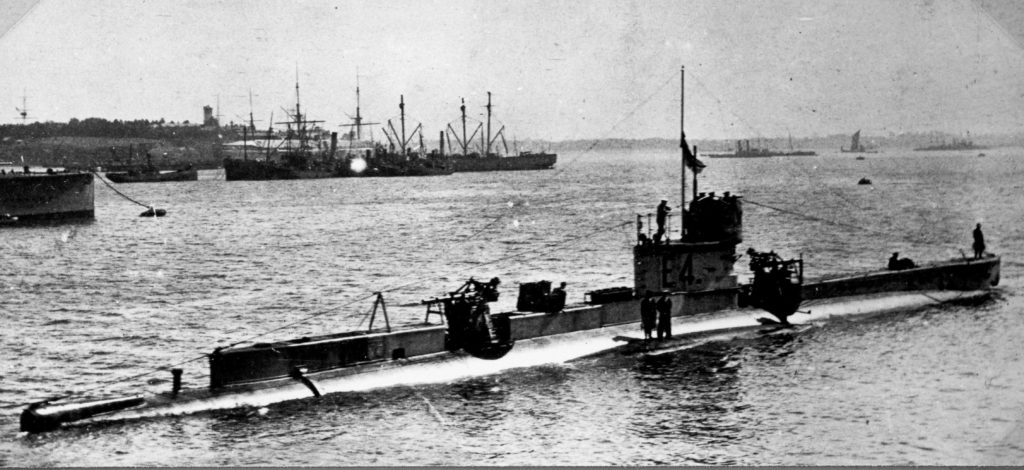
E4
- Laid Down. 16/05/1911
- Launched. 05/12/1912
- Completed. 04/01/1913
- Builder. Vickers
- Build Group. E1
- Length 181 ft.
- Diving Depth. 200 ft.
- Speed. 15.25 Knots
- Complement. 30
- Fate. Scrapped 21/02/1922
E4 was built by Vickers, Barrow-in-Furness, costing £101,900. launched on 5 February 1912 and commissioned on 28 January 1913. Whilst carrying out anti-submarine exercises in the North Sea on the 15th August 1916, E41 acting as a target, had begun a surface passage of 12 knots when E4s periscope appeared 50 yards off her starboard bow, on a collision course. E41 stopped her engines but not before E4 collided forward of the bridge. E41 began to take in water through the forward battery Compartment and began to sink by the bow. There were no Survivors from E4. Both boats were raised, repaired and recommissioned. E4 was sold on 21 February 1922.
HMS E5
- Laid Down. 09/06/1911
- Launched. 17/05/1912
- Completed. 07/06/1913
- Builder. Vickers
- Build Group. E1
- Length. 181 ft.
- Diving Depth. 200 ft.
- Speed. 15.25 Knots
- Complement. 30
- Fate. Sunk 07/03/1916
E5 was built by Vickers Barrow-in-Furness and launched on the 17th May 1912. E5 had a very short career before and after her commissioning. 08.10 on the morning of 7th March 1916 the German battle cruiser Seydlitz sighted a submarine north of Juist Island. The cruiser and her accompanying torpedo boats dropped depth charges but to no avail. a few hours later another German cruiser, the Regensburg sighted a submarine to the east, not far from a German minefield of the Western Ems. E5 failed to return from her patrol and it is believed that this was the submarine seen by the Regensburg near the minefield E5 met her fate while rescuing the survivors of trawler Resono just north of Juist in the North Sea; she was mined on the 7 March 1916.
HMS E6
- Launched. 12/11/1912
- Completed. 15/10/1913
- Builder. Vickers
- Build Group. E1
- Length. 181 ft.
- Diving Depth. 200 ft.
- Speed. 15.25 Knots
- Complement. 30
- Fate. Mined 26/12/1915
E6 was built by Vickers Barrow-in-Furness and was launched on the 12th of November 1912. E6 had a short career in World War I. On 5 August 1914, she was towed by the light cruiser Attentive to Terschelling along with E8 which was towed by the destroyer Ariel. E6 and E8 then made the first Heligoland Bight Patrol. On 28 August 1914, E6 and E8 other boats took positions in a planned raid against the German Heligoland Bight Patrol using surface ships. On 25 September 1914, E6 fouled on two mines in Heligoland Bight, but escaped.
On Boxing Day 1915, E6 left Harwich on a six-day mission to intercept any U-boats passing by ‘Horns Reef’. Despite a warning about mines following the sinking of an armed trawler that morning, the E6 continued on its course. Detonating a mine, the submarine and all her 38 crew sank under a cloud smoke and debris. A wreck which is believed to be the E6 lies some 40 miles off the coast of Harwich, where divers have reported a submarine with the bows blown apart and partially buried in sand.
HMS E7
- Laid Down. 30/03/1912
- Launched. 02/10/1913
- Completed. 14/03/1914
- Builder. Chatham Dockyard
- Build Group. E2
- Length. 181 ft.
- Diving Depth. 200 ft.
- Speed. 15.25 Knots
- Complement. 30
- Fate. Scuttled 04/09/1915
E7 was laid down on No 7 slip on 30th March 1912. She was launched by Miss Anson, the daughter of the Admiral Superintendent at Chatham at the time, Rear Admiral Charles Anson on 2nd October 1913. She commissioned after fitting out at Chatham on 16th March 1914, under Lt-Cdr Fielmann. On the outbreak of WW1 E7 was stationed in Harwich, conducting patrols in Heligoland Bight, but was sent to the Sea of Marmara in June 1915 to relieve E14. By now, she had a new commander, Lt-Cdr Cochrane. On passing through the Dardanelles, she was fired at by a shore based torpedo crew and a Turkish destroyer made two attempts to ram her. She managed to get through unscathed and relieved E14 on 30th June. Her patrol of the Marmara Sea was to last 24 days. At the end of August she began her journey home, but on 4th September 1915, while attempting to pass under the Turkish anti-submarine nets at Nagara, one of her propellers became entangled. Her attempts to free herself did not pass unnoticed by the Turks and they soon started attacking the boat with bombs dropped from small boats.At the time, the German submarine UB-14 was undergoing repairs at Chanak. Her commander heard the explosions and decided to take a close look at what was going on. He and the U-Boat’s cook went out in a small rowing boat to observe the action. On seeing that the Turks efforts were having no effect, they decided to use a plumb-line in an attempt to find the British submarine. The line was repeatedly dropped until he felt it contact metal. they then dropped a Turkish sinker mine with a shortened fuse right on top of E7. By the time this happened, E7 had been trapped in the net for 12 hours. The explosion was too close for comfort and with his crew running short of air, Lt-Cdr Cochrane realised the game was up. Once the confidential papers had been destroyed and the scuttling charges set, he ordered that E7 be surfaced to allow the crew to escape. After everyone was off the boat, the charges were set off and E7 went to the sea-bed for good. E7’s officers and crew were taken into captivity for the rest of the war.
HMS E8
- Laid Down. 30/03/1912
- Launched. 30/10/1913
- Completed. 13/06/1914
- Builder. Chatham Dockyard
- Build Group. E2
- Length. 181 ft..
- Diving Depth. 200 ft.
- Speed. 15.25 Knots
- Complement. 30
- Fate. Scuttled 04/04/1918
E8 was laid down on No 7 slip on 30th March 1912. She was launched into the River Medway by Miss Ollis on 30th October 1913. After fitting out at Chatham, she was commissioned on 18th June 1914. on completion, she was 178ft long and 15ft 5″ wide at the beam. She displaced 665 tons on the surface and 796 tons when submerged. The boat was armed with 4 18″ torpedo tubes, one in the bow, one on each beam and one in the stern. She also carried a deck gun. She had a crew of 30 men. At the outbreak of the First World War, E8 was with 8th Submarine Flotilla at Harwich, attached to the depot ship HMS Maidstone. On 28th August 1914, she was part of a force of submarines stationed 4 miles out to sea in the Heligoland Bight as part of the British forces participating in the Battle of Heligoland Bight. On 15th August 1915, E8 sailed to join the Baltic Flotilla supporting the Russians, a passage which did not pass without incident. E8 had a number of escapes from German patrol vessels, eventually arriving safely in Reval. Despite Reval harbour being iced up, she did make a war patrol but on her return, was in collision with a Russian submarine which left the boat badly damaged and out of action for weeks. In April 1918, German forces intervened in the Finnish Civil War and the submarines of the Baltic Flotilla found themselves in an untenable position.The decision was taken to scuttle all the boats of the flotilla to prevent them falling into German hands. On 4th April 1918,E8 left Helingford in company with E1, E9 and E19. The other boats were successfully scuttled, but E8’s charges failed to go off. E8 then spent the night at sea before being joined by C26 and C35. She was tied up alongside C26 and both boats were blown up. The wreck of E8 was salvaged in August 1953 and was broken up in Finland
HMS E9
- Laid Down. 01/06/1912
- Launched. 29/10/1913
- Completed. 16/06/1914
- Builder. Vickers
- Build Group. E2
- Length. 181 ft.
- Diving Depth. 200 ft.
- Speed. 15.25 Knots
- Complement. 30
- Fate. Scuttled 03/04/1918
E9 was a British E class submarine built by Vickers, Barrow. She was laid down on 1st June 1912 and was commissioned on 18th June 1914. At dawn on 13th September 1914, the submarine, commanded by Lieutenant-Commander Horton, torpedoed the German light cruiser Hela six miles southwest of Heligoland. Hela was hit amidships with the two torpedoes, fired from a range of 600 yards. All but two of her crew were rescued by the German submarine U-18 and another German ship. Although pursued most of the day by German naval forces, E9 managed to reach Harwich safely. Three weeks later, Horton sank the German destroyer S 116 off the mouth of the River Ems. for sinking the cruiser and the destroyer, Horton was awarded the Distinguished Service Order (DSO). E9 was scuttled outside Helsinki (Helsingfors) 1.5 nautical miles (2.8 km; 1.7 mi) off Grohara Light in the Gulf of Finland on 3 April 1918 to avoid seizure by advancing German forces. E9 was salvaged for breaking in Finland in August 1953
HMS E10
- Launched. 29/11/1913
- Completed. 10/08/1914
- Builder. Vickers
- Build Group. E2
- Length. 181 ft.
- Diving Depth. 200 ft.
- Speed. 15.25 Knots
- Complement. 30
- Fate. Mined 18/01/1915
E10 was launched on the 29th of November 1913. After commissioning, E10 joined the 8th Submarine Flotilla based on HMS Maidstone at Harwich and sailed from the town in company of D3 and D5 for North Sea Patrols. on January 18,1915 she took part in an operation which was part of a plan by the Admiralty for a destroyer raid, codenamed Plan J, on the German outer patrol which was reported to be holding the line between Borkum and Horn Reefs. There was no encounter with the enemy and at about 8pm, E10, commanded by Lt Cdr William St J Fraser. when she left Harwich, was seen to set course for the south. This was the last sighting and it was assumed shed had run into a minefield. It is believed that E10 was destroyed by an enemy mine. E10 sank in January 1915 and was discovered off Germany in 2002 and is now preserved as a war grave.
HMS E11

E11
- Launched. 23/04/1914
- Completed. 19/09/1914
- Builder. Vickers
- Build Group. E2
- Length. 181 ft.
- Diving Depth. 200 ft.
- Speed. 15.25 Knots
- Complement. 30
- Fate. Scrapped 1921
E11 was built by Vickers of Barrow and launched on 23 April 1914. E11 was one of the most successful submarines in action during the 1915 Dardanelles Campaign against Turkey, sinking more than 80 vessels of all sizes in three tours of the Sea of Marmara. E11 passed through the Dardanelles on the night of 18 May. Surfacing off the town of Gallipoli, Captain Nasmith captured a Turkish sailing vessel and lashed it to the conning tower to act as a disguise. This ruse failed to attract any targets, so after several days he abandoned it. E11 made a total of three tours of the Sea of Marmara and sank 27 steamers and 58 smaller vessels.
HMS E12
- Laid Down. 16/12/1912
- Launched. 05/09/1914
- Completed. 14/10/1914
- Builder. Chatham Dockyard
- Build Group. E2
- Length. 181 ft.
- Diving Depth. 200 ft.
- Speed. 15.25 Knots
- Complement. 30
- Fate. Scrapped 07/03/1921
E12 was built by HM Dockyard, Chatham and was launched on the 5th of December 1912. The outbreak of the Great War saw her at Harwich with the 8th Submarine Flotilla, supported by HMS Maidstone. On 6th February 1915, she left Harwich for a patrol off the western Ems, but poor weather made her end her patrol early. Later in the year, on April 17th, she was returning to Harwich from another patrol when she was bombed by enemy aircraft but escaped without damage or casualties. E12 survived the war but by the end of 1918, E12 was obsolete. She was sold for scrap on 7th March 1921 and was broken up in Malta.
HMS E13
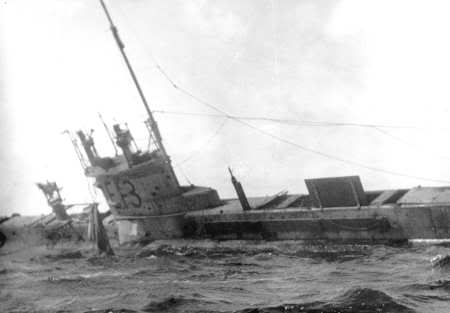
E13
- Laid Down. 16/12/1912
- Launched. 22/09/1914
- Completed. 09/12/1914
- Builder. Chatham Dockyard
- Build Group. E
- Length. 181 ft.
- Diving Depth. 200 ft.
- Speed. 15.25 Knots
- Complement. 30
- Fate. Scrapped 14/12/1921
E13 was built by HM Dockyard, Chatham, and was launched on the 22nd of September 1914. in May 1915, E13 left Harwich to patrol the north German coast. During her patrol she sighted and attacked the German Zeppelin L9. The L9 then retaliated by attempting to bomb the E13, forcing her to dive. On the same patrol, she sighted but did not attack two German fleet auxiliaries. on 18th August, her gyro compass failed and unable to correct her course in time, she ran aground near Saltholm Island, between Malmo and Copenhagen at about 01:00. By 05:00, it was getting light and she was sighted by the Royal Danish Navy torpedo boat Narhvalen. The Danish vessel informed E13’s commander that in line with International Law, he had 24 hours to refloat his vessel and leave or his submarine and crew would be interned for violating Danish neutrality.
HMS E14
- Laid Down. 14/12/1912
- Launched. 07/07/1914
- Completed. 01/12/1914
- Builder. Vickers
- Build Group. E2
- Length. 181 ft.
- Diving Depth. 200 ft.
- Speed. 15.25 Knots
- Complement. 30
- Fate. Sunk 28/01/1918
E14 was built by Vickers, Barrow-in-Furness. During the First World War, two of her captains were awarded the Victoria Cross, and a large number of her officers and men also decorated. E14 was laid down on 14 December 1912 and was commissioned on 18 November 1914. Her hull cost £105,700. E14 was employed in the Dardanelle’s theatre of war. Her distinction is that she had two commanding officers, each of whom won the Victoria Cross in the same area but three years apart. In June 2012, after a three-year search, Turkish marine engineer Selçuk Kolay and filmmaker Savas Karakas discovered the wreck of E14 in 20 m of water about 250 m off Kum Kale. The ship is largely buried in sand, only 7 m of the coral-encrusted bow, with a shell hole, remaining visible. The British government is to ask the Turkish authorities to ensure the wreck is respected as a war grave.
HMS E15
- Laid Down. 14/10/1912
- Launched. 23/04/1914
- Completed. 15/10/1914
- Builder. Vickers
- Build Group. E2
- Length. 181 ft.
- Diving Depth. 200 ft.
- Speed. 15.25 Knots
- Complement. 30
- Fate. Torpedoed 17/04/1915
E15 was built by Vickers, Barrow-in Furness and was launched on the 23rd April 1914. During World War I, E15 served in the Mediterranean, participating in the Gallipoli Campaign against the Ottoman Empire. On 16 April 1915, under the command of Lieutenant Commander T.S. Brodie, E15 sailed from her base at Mudros and attempted to break through the Dardanelles to the Sea of Marmara. Early in the morning of 17 April, the submarine, having dived too deep and become caught in the vicious current, ran aground some ten miles (16 km) in near Kepez Point directly under the guns of Fort Dardanus. E15 was soon hit and disabled; Brodie was killed in the conning tower by shrapnel and six of the crew were killed by chlorine gas released when the submarine’s batteries were exposed to seawater after a second shell strike. Forced to evacuate the vessel, the remaining crew surrendered, to be incarcerated in a prisoner of war camp near Istanbul where six later died. E15 remains off Kepez Point in 8 m of water. The bodies of Lieut. Commander Brodie and several crew, initially buried on a beach nearby, were reinterred at the Chanak Consular Cemetery.
HMS E16
- Laid Down. 15/05/1913
- Launched. 23/09/1914
- Completed. 26/02/1915
- Builder. Vickers
- Build Group. E2
- Length. 181 ft.
- Diving Depth. 200 ft.
- Speed. 15.25 Knots
- Complement. 30
- Fate. Mined 22/08/1916
E16 was built by Vickers, Barrow-in-Furness for the Royal Navy. She was laid down on 15 May 1913 and was commissioned on 27 February 1915. Her hull cost £105,700. E16 was the first E-class to sink a U-boat U-6 south-west of Karmøy island off Stavanger, Norway on 15 September 1915. E16 was last sighted thirty-five miles east of Yarmouth. E38 later observed a group of warships moving north, in the vicinity of Terschelling, Splashes were seen near to one of the warships which may have been depth charges exploding. E16 was sunk by a mine in Heligoland Bight on 22 August 1916. There were no survivors.
HMS E17
- Laid Down. 16/02/1915
- Launched. 16/01/1915
- Completed. 07/04/1915
- Builder. Vickers
- Build Group. E2
- Length. 181 ft.
- Diving Depth. 200 ft.
- Speed. 15.25 Knots
- Complement. 30
- Fate. Stranded 06/01/1916
E17 was built by Vickers, Barrow-in-Furness. She was laid down on 16 February 1915 and was commissioned on 7 April 1915. Whilst patrolling north of Texel Island, E17 struck an uncharted sandbank; the badly damaged submarine was forced to surface. The Royal Netherlands Navy Cruiser Noord Brabant approached the stricken submarine to investigate. E17 believing the Cruiser was belligerent submerged, but owing to the damage was forced to surface again. E1 signalled the un-identified cruisers for assistance and her crew were taken off and interned. E17 finally sank at 1140 on Thursday 6th January 1916. E17 stayed on the bottom of the North Sea for 70 years, until a Dutch diver discovered it, this Conning Tower was Brought to HMS Dolphin on the 10th March 1988.
HMS E18
-
Launched. 04/03/1915
-
Completed. 06/06/1915
-
Builder. Vickers
-
Build Group. E2
-
Length. 181 ft.
-
Diving Depth. 200 ft.
-
Speed. 15.25 Knots
-
Complement. 30
-
Fate. Mined 02/06/1916
E18 was built by Vickers , Barrow and was launched on the 4th of March 1915. E18 – with its complement of three officers and 28 ratings – went out on patrol in May 1916 and was never seen again. The submarine was one of a handful sent to the Baltic during World War I by Winston Churchill to disrupt German shipments of iron ore from Sweden and support the Russian navy. E18 left its base in the Russian port of Reval, Estonia on the evening of 25 May 1916 and headed west. The following day she was reported to have engaged and torpedoed a German ship. A few days later, possibly 2 June, she is believed to have struck a German mine and sunk with all hands. E18 was the only E-class submarine lost on active service in the Baltic; the rest were scuttled by the Navy off Helsinki in April 1918 to avoid capture by advancing German forces The submarine was found in 2009 close to the Estonian island of Hiiumaa by a Swedish marine survey company.
HMS E19
- Laid Down. 27/11/1914
- Launched. 13/05/1915
- Completed. 12/07/1915
- Builder. Vickers
- Build Group. E2
- Length. 181 ft.
- Diving Depth. 200 ft.
- Speed. 15.25 Knots
- Complement. 30
- Fate. Scuttled 08/04/1918
E19 was built by Vickers, Barrow-in-Furness and launched on the 13th May 1915. During World War I she was part of the British submarine flotilla in the Baltic. Under the command of Lieutenant Commander Francis Cromie, E19 was able to sink several German ships, most notably on the 11 October 1915 when she sank 4 German transport ships, just south of Öland, within a few hours and without any casualties. On 7 November 1915 E19 sank the German light cruiser SMS Undine. E19 was scuttled by her crew outside Helsinki 1.5nm south of Harmaja Light, Gulf of Finland, along with E1, E8, E9, C26, C27, and C35 to avoid seizure by advancing German forces who had landed nearby.
HMS E20
- Laid Down. 25/11/1914
- Launched. 12/06/1915
- Completed. 30/08/1915
- Builder. Vickers
- Build Group. E2
- Length. 181 ft.
- Diving Depth. 200 ft.
- Speed. 15.25 Knots
- Complement. 30
- Fate. Torpedoed 06/11/1915
E20 was built by Vickers, Barrow-in-Furness. She was laid down on 25 November 1914 and was commissioned on 30 August 1915. on the 30th October 1915 the French submarine Turquoise ran aground near Nagara Point, in the Dardanelles. With the submarine directly under the Turkish shore batteries the French crew hastily abandoned ship. Unfortunately for E20, who was due to rendezvous with the Turquoise, the French Captain had failed to destroy his confidential papers. The Germans now knew of the rendezvous and dispatched U14 to intercept the unsuspecting E20. At 1700 she fired a single torpedo that hit the conning tower that sank her. 21 crew lost their lives and 9 were rescued by U14 which included the captain who was brushing his teeth at the time.
HMS E21
- Laid Down. 29/07/1915
- Launched. 24/07/1915
- Completed. 01/10/1915
- Builder. Vickers
- Build Group. E2
- Length. 181 ft.
- Diving Depth. 200 ft.
- Speed. 15.25 knots
- Complement. 30
- Fate. Scrapped 1921
E21 was built by Vickers, Barrow-in-Furness. She was laid down on 29 July 1915 and was commissioned on 1 October 1915. The E class served with the Royal Navy throughout World War I as the backbone of the submarine fleet and were eventually replaced by the British L class submarine. All the E class submarines were withdrawn from service by 1922.
HMS E22
- Laid Down. 27/08/1914
- Launched. 27/08/1915
- Completed. 08/11/1915
- Builder. Vickers
- Build Group. E3
- Length. 181 ft.
- Diving Depth. 200 ft.
- Speed. 15.25 Knots
- Complement. 30
- Fate. Torpedoed 25/04/1916
E22 was built by Vickers, Barrow-in-Furness. She was laid down on 27 August 1914 and was commissioned on 8 November 1915. E22 was involved in experiments in the North Sea to intercept Zeppelins on 24 April 1916. E22 carried two Sopwith Schneider seaplane scouts on her casing. The boat would then submerge in calm waters and the planes would float on the surface. They would then take off and then return to the East coast of England in Felixstowe. E22 was torpedoed by the German U-boat UB-18 off Great Yarmouth in the North Sea on 25 April 1916. There were no survivors.
HMS E23
- Launched. 28/09/1915
- Completed. 06/12/1915
- Builder. Vickers
- Build Group. E3
- Length. 181 ft.
- Diving Depth. 200 ft.
- Speed. 15.25 Knots
- Complement. 30
- Fate. Scrapped 06/09/1922
E23 was built by Vickers, Barrow-in-Furness. She was laid down on the 28 September 1914 and was commissioned on 6 December 1915. The E class served with the Royal Navy throughout World War I as the backbone of the submarine fleet and were eventually replaced by the British L class submarine. All the E class submarines were withdrawn from service by 1922. E23 torpedoed the German dreadnought SMS Westfalen (18,900 tons), holing her off Terschelling on 19 August 1916. E23 was sold on 6 September 1922.
HMS E24
- Launched. 09/12/1915
- Completed. 10/01/1916
- Builder. Vickers
- Build Group. E3
- Length. 181 ft.
- Diving Depth. 200 ft.
- Speed. 15.25 Knots
- Complement. 30
- Fate. Mined 24/03/1916
E24 was built by Vickers, Barrow-in-Furness. She was launched on 9 December 1915 and was commissioned on 9 January 1916. E24 left Harwich on the morning of 21 March 1916 to lay mines in the Helgoland Bight. Her commander, Lieutenant-Commander Naper, was ordered to enter the Bight in darkness on the surface via the Amrum Bank. Once in position he was to lay mines in a zigzag formation. As mines were known to have been laid by the Germans off Ameland, Naper was ordered to return by the same route. She did not return from the mission, and was logged as missing on 24 March 1916. Human remains found in the wreck are buried in Ohlsdorf, Hamburg. E24’s commander is buried in a separate grave to others. Lieutenant-Commander Naper was identified because of the 2+half rings on sleeve, and the fact that his skeleton was 6 ft. tall. All the skulls of those in the boat were found in a pyramidal formation. The sunken wreck lay at a downward angle, causing the heads to become detached from the bodies and to roll down the slope into that position. Three bodies were found lying under the battery boards directly on top of the batteries, with arms folded. They may have died of the effects of chlorine gas before the rest of the crew.
HMS E25
- Laid Down. 1914
- Launched. 23/08/1915
- Completed. 04/101/1915
- Builder. William Beardmore
- Build Group. E3
- Length. 181 ft.
- Diving Depth. 200 ft.
- Speed. 15.25 Knots
- Complement. 30
- Fate. Scrapped 14/12/1921
E25 was built by William Beardmore and Company, Dalmuir. She was one of a pair of submarines ordered by the Ottoman Navy on 29 April 1914, but was taken over by the Royal Navy and assigned the E25 name. She was laid down in November 1914, launched on 23 August 1915, and was commissioned on 4 October 1915. The E class served with the Royal Navy throughout World War I as the backbone of the submarine fleet and were eventually replaced by the British L class submarine. E25 was sold on 14 December 1921.
HMS E26
- Launched. 11/11/1915
- Completed. 03/10/1915
- Builder. William Beardmore
- Build Group. E3
- Length. 181 ft.
- Diving Depth. 200 ft.
- Speed. 15.25 Knots
- Complement. 30
- Fate. Sunk 06/07/1916
E26 was built by William Beardmore and Company, Dalmuir. She was, along with the future E25, one of a pair of submarines ordered by the Ottoman Navy on 29 April 1914, but was taken over by the Royal Navy and assigned the E26 name. She was laid down in November 1914, launched on 11 November 1915, and was commissioned on 3 October 1915. on the 2nd July 1916 a German Patrol boat reported a trail of oil on the surface just off the Ems that was thought to be emanating from a submarine. The following day German forces attacked a British submarine with both gunfire and bombs. This vessel is believed to be E26 as she failed to return from her patrol. E26 was lost in the North Sea on 6 July 1916. There were no survivors.
HMS E27
- Laid Down. 1916
- Launched. 09/06/1917
- Completed. 01/08/1917
- Builder. Yarrow
- Build Group. E3
- Length. 181 ft.
- Diving Depth. 200 ft.
- Speed. 15.25 Knots
- Complement. 30
- Fate. Scrapped 06/09/1922
E27 was built by Yarrow Shipbuilders, Scotstoun. She was laid down on 9 June 1917 and was commissioned in August 1917. The E class served with the Royal Navy throughout World War I as the backbone of the submarine fleet and were eventually replaced by the British L class submarine. All the E class submarines were withdrawn from service by 1922. E27 was sold in Newport on 6 September 1922.
HMS E29
- Launched. 01/06/1915
- Completed. 01/101/1915
- Builder. Armstrong Whitworth
- Length. 181 ft.
- Diving Depth. 200 ft.
- Speed. 15.25 Knots
- Complement. 30
- Fate. Scrapped 21/02/1922
E29 was built by Armstrong Whitworth, Newcastle-Upon-Tyne. She was laid down on 1 June 1915 and was commissioned in October 1915. The E class served with the Royal Navy throughout World War I as the backbone of the submarine fleet and were eventually replaced by the British L class submarine. All the E class submarines were withdrawn from service by 1922. E29 suffered an explosion in the battery compartment which killed four men on 9 January 1916. She was sold on 21 February 1922.
HMS E30
- Laid Down. 01/12/1914
- Launched. 29/06/1915
- Completed. 01/11/1915
- Builder. Armstrong Whitworth
- Build Group. E3
- Length. 181 ft.
- Diving Depth. 200 ft.
- Speed. 15.25 Knots
- Complement. 30
- Fate. Mined 25/11/1916
E30 was built by Armstrong Whitworth, Newcastle upon Tyne. She was laid down on 29 June 1914 and was commissioned in November 1915. E30 left Harwich on November 15th and was sunk in the North Sea, possibly due to a mine off Orford Ness. The minefield was not located until 25th November. There were no survivors.
HMS E31
- Launched. 23/08/1915
- Completed. 27/12/1915
- Builder. Scott’s
- Build Group. E3
- Length. 181 ft.
- Diving Depth. 200 ft.
- Speed. 15.25 Knots
- Complement. 30
- Fate. Scrapped 06/09/1922
E31 was built by Scotts, Greenock. She was laid down in December 1914 and was commissioned on 8 January 1916. E31 was involved in a curious incident when she was operating with the sea plane carrier Engadine in the North Sea in an air raid on the Zeppelin sheds at Tondern on 4 May 1916. E31 surfaced and spotted Zeppelin L7. She dived to avoid attack. While at periscope depth, it was observed that the Zeppelin was losing altitude as it had been hit by shells from the light cruisers Galatea and Phaeton.
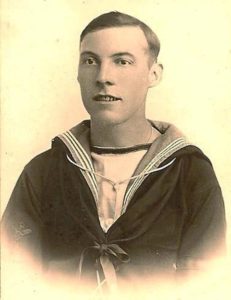
Horace Brumbridge
E31 surfaced to shoot the Zeppelin down and rescued seven survivors. E31 was sold on 6 September 1922.
Horace Walter Brumbridge Horace was my Dad’s favourite Uncle. He was on HMS Sentinel in 1914, My Dad also noted that Horace was on submarine HMS E31. Horace Brumbridge died Dec 1924 (aged 29/30 years), when my Dad was aged 8 years. I recall my Dad (who died Feb 1986) saying that Horace may’ve been affected by the ‘bends’ ? Unconfirmed.
Martina Farrow, Great Niece of Horace Brumbridge.
https://www.europeana.eu/portal/en/record/2020601/contributions_4337.html
HMS E32
- Laid Down. 24/12/1914
- Launched. 16/08/1915
- Completed. 01/10/1916
- Builder. J. Samuel
- Build Group. E
- Length. 181 ft.
- Diving Depth. 200 ft.
- Speed. 15.15 Knots
- Complement. 30
- Fate: Scrapped 1922
E32 was built by J. Samuel White, Cowes, Isle of Wight. She was laid down on 16 August 1916 and was commissioned in October 1916. E32 was sold in Sunderland on 6 September 1922.
HMS E33
- Launched. 18/04/1916
- Completed. 01/11/1916
- Builder. John Thornycroft
- Build Group. E3
- Length. 181 ft.
- Diving Depth. 200 ft.
- Speed. 15.15 Knots
- Complement. 30
- Fate. Scrapped 06/09/1922
E33 was built by John Thornycroft, Woolston, Hampshire. She was launched on 18 April 1916 and was commissioned in November 1916. E33 was sold in Newport on 6 September 1922.
HMS E34
- Laid Down. 1916
- Launched. 27/01/1917
- Completed. 01/03/1917
- Builder. John Thornycroft
- Build Group. E3
- Length. 181 ft.
- Diving Depth. 200 ft.
- Speed. 15.25 Knots
- Complement. 30
- Fate. Mined 20/07/1918
E34 was built by John Thornycroft, Woolston, Hampshire. She was laid down on 21 January 1917 and was commissioned in March 1917. E34 sank the U-Boat UB-16 off Harwich in the North Sea on 10 May 1918. On the morning of 20th July 1918 E34 was mined near the Eijerlandse Gronden, the sands between the Frisian islands Texel and Vlieland. There were no survivors.
Percy Baron Richens was a signaller on E34 on her last mission, he joined the RN in 1906, his family were farmers around Hungerford, his mother Annie Richens (nee Beard) was my great grt Aunt.
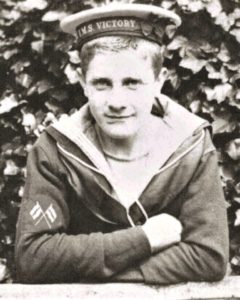
Percy Baron Richens
E34 and her crew are one of the most photographed submarines/crew as a photographer form (I think) a national newspaper spent a few days prior to her last mission photographing both the crew and the submarine.
Text and photos by kind permission of Tony Beard.
HMS E35
- Launched. 20/05/1916
- Completed. 14/07/1916
- Builder. John Brown
- Build Group. E3
- Length. 181 ft.
- Diving Depth. 200 ft.
- Speed. 15.25 Knots
- Complement. 30
- Fate. Scrapped 1935
E35 was built by John Brown, Clydebank. She was laid down on 20 May 1916 and was commissioned on 14 July 1917. E35 sank U-154(one of the 1,512 ton U-boat cruisers originally designed as cargo carrying blockade runners) off the island of Madeira on 11 May 1918. This sinking was helped by British intelligence who had learned of a planned rendezvous between two U-boats off Cape St Vincent. E35 was sold in 6 September 1922.
HMS E36
- Launched. 16/09/1916
- Completed. 16/11/1916
- Builder. John Brown
- Build Group. E3
- Length. 181 ft.
- Diving Depth. 200 ft.
- Speed. 15.25 Knots
- Complement. 30
- Fate. Lost 19/01/1917
E36 was built by John Brown, Clydebank and was launched on the 16th September 1916. E36 and E43 left Harwich at 0730 on 19th January 1917 for two patrol areas off Terschelling. A strong north easterly was blowing. At 1126 just before they left the coast, E43 signalled to E36 to proceed independently. At 1330 E36 was on the port beam but was out of sight by 1500. The sea was running fairly high and at 1850 E43, having lost her bridge screen, eased to 5 knots and turned 16 points to fit a new one. This delay must have enabled E36 to overtake her, for at 1950 off the Haaks LV, E43 had just altered course to true north when she suddenly sighted a submarine 3 points on the port bow apparently steering east and only 50 yards off. The helm was put hard to starboard and engines full astern but E43 struck E36 aft from the stern, rode right over her and saw her vanish on the starboard quarter in the darkness. E43 went astern but nothing could be seen in the darkness and heavy sea. Nothing more was heard of E36.
HMS E37

E37
- Launched. 02/09/1915
- Completed. 17/03/1916
- Builder. Fairfield
- Build Group. E3
- Length. 181 ft.
- Diving Depth. 200 ft.
- Speed. 15.25 Knots
- Complement. 30
- Fate. Mined 01/12/1916
E37 was built by Fairfield, Govan, Clyde and was launched on the 2nd of September 1915. E37 was lost on the night of 30th November/1st December 1916.
Lieutenant Commander Robert Fellowes Chisholm had sailed from Harwich in company with E54. It is thought that E37 was lost in a minefield off Orford Ness. There were no survivors.
HMS E38
- Laid Down. 13/06/1916
- Launched. 13/06/1918
- Completed. 10/07/1916
- Builder. Fairfield
- Build Group. E3
- Length. 181 ft.
- Diving Depth. 200 ft.
- Speed. 15.25 Knots
- Complement. 30
- Fate. Scrapped 06/09/1922
E38 was built by Fairfield, Govan, Clyde and was launched on the 13th of June 1916 and was commissioned on 10 July 1917. E38 was sold in Newport on 6 September 1922
HMS E39
- Laid Down. 18/05/1916
- Launched. 18/05/1916
- Completed. 30/09/1916
- Builder. Palmers
- Build Group. E3
- Length. 181 ft.
- Diving Depth. 200 ft.
- Speed. 15.25 Knots
- Complement. 30
- Fate. Scrapped 13/10/1921
E39 was launched by Palmers, Jarrow on the 18th of May 1916 and was completed by Armstrong Whitworth, Newcastle upon Tyne. She was commissioned in October of the same year and spent her career with the 10th Flotilla on the Tees, before being sold for scrap in on the 13th October 1921. on the 13th September 1922, on her way to the breakers under tow, she foundered in Watick Bay, Milford Haven.
HMS E40
- Launched. 09/11/1916
- Completed. 01/05/1917
- Builder. Palmers
- Length. 181 ft.
- Diving Depth. 200 ft.
- Speed. 15.25 Knots
- Complement. 30
- Fate. Scrapped 14/12/1921
E40 was launched by Palmer, Jarrow on the 9th of November 1916 and was completed by Armstrong Whitworth, Newcastle upon Tyne. E40 was sold on 14 December 1921.
HMS E41
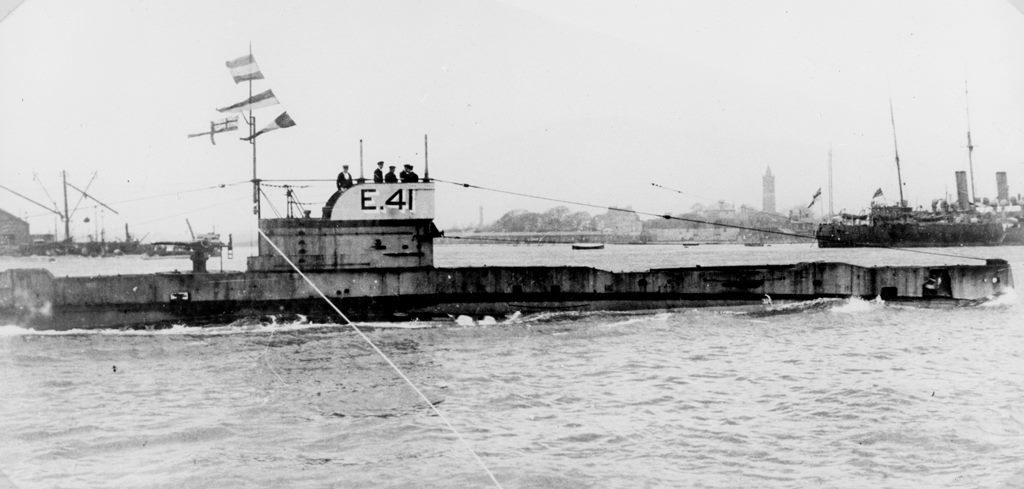
E41
- Launched. 22/10/1915
- Completed. 01/02/1916
- Builder. Cammell Laird
- Build Group. E3
- Length. 181 ft.
- Diving Depth. 200 ft.
- Speed. 15.25 Knots
- Fate. Scrapped 06/09/1922
E41 was built by Cammell Laird, Birkenhead and was launched on the 22nd of October 1915. During the summer of 1916, two British submarines collided on a North Sea exercise off the coast of Harwich. The ship HMS Firedrake, there to monitor the exercise, picked up 20 of the crew of one of the boats, E41 – one of whom had a miraculous escape.
Petty Officer Brown was trapped in the E41 as it flooded. Standing in pitch black dark while the level of water in the hold rose, breathing in deadly chlorine gas, frequently receiving electric shocks from the flooded equipment, PO Brown had to wait for the water to rise and the air pressure in the engine compartment to drop enough and try and enable him to open a hatch and escape.
One hour and 30 minutes after the submarine sank, with ice cold water now up to his chin, PO Brown was able to open the hatch and swim to the surface to the amazement of the ships above.

Stoker’s dramatic escape
16 men from E41 died. There were no survivors from the other submarine, E4, where 33 men died.
E41 was raised in September 1917 and was recommissioned. She was sold in Newcastle on 6 September 1922.
HMS E42
- Laid Down. 01/12/1914
- Launched. 22/10/1915
- Completed. 01/06/1916
- Builder. Cammell Laird
- Build Group. E3
- Length. 181 ft.
- Diving Depth. 200 ft.
- Speed. 15.25 Knots
- Complement. 30
- Fate. Scrapped 06/09/1922
E42 was built by Cammell Laird, Birkenhead and was launched on the 22nd of October 1915 and commissioned in July 1916. E42 was sold on 6 September 1922.
HMS E43
- Laid Down. 22/12/1914
- Launched. 11/11/1915
- Completed. 29/02/1916
- Builder. Swan Hunter
- Build Group. E3
- Length. 181 ft.
- Diving Depth. 200 ft.
- Speed. 15.25 Knots
- Complement. 30
- Fate. Scrapped 1921
E43 was built by Swan Hunter, Wallsend and was launched on the 11th of November 1915. E43 collided with E36 off Harwich in the North Sea; E36 sank with all hands. She was sold on 3 January 1921 but became stranded under tow on 25 November 1921.
HMS E44
- Laid Down. 08/01/1916
- Launched. 21/02/1916
- Completed. 18/07/1917
- Builder. Swan Hunter
- Build Group. E3
- Length. 181 ft.
- Diving Depth. 200 ft.
- Speed. 15.25 Knots
- Complement. 30
- Fate. Scrapped 13/10/1921
E44 was built by Swan Hunter, Wallsend and was launched on the 21st of February 1916. on the 18th July, she was also commissioned to the 10th Flotilla. The E class served with the Royal Navy throughout World War I as the backbone of the submarine fleet and were eventually replaced by the British L class submarine. E44 was sold for scrapping on the 13th October 1922.
HMS E45
- Launched. 25/01/1916
- Completed. 01/08/1916
- Builder. Cammell Laird
- Build Group. E3
- Length. 181 ft.
- Diving Depth. 200 ft.
- Speed. 15.25 Knots
- Complement. 30
- Fate. Scrapped 06/09/1922
E45 was built by Cammell Laird, Birkenhead and launched on the 25th of January 1916. E45 torpedoed U-Boat UC-62 in the North Sea on 15 October 1917, and was sold on 6 September 1922.
HMS E46
- Launched. 04/04/1916
- Completed. 01/10/1916
- Builder. Cammell Laird
- Build Group. E3
- Length. 181 ft.
- Diving Depth. 200 ft.
- Speed. 15.25 Knots
- Complement. 30
- Fate. Scrapped 06/09/1922
E46 was built by Cammell Laird, Birkenhead and launched on the 4th of April 1916. E46 was sold in South Wales on 6 September 1922.
HMS E47
- Laid Down. 01/01/1915
- Launched. 29/05/1916
- Completed. 01/10/1916
- Builder. Fairfield
- Build Group. E3
- Length. 181 ft.
- Diving Depth. 200 ft.
- Speed. 15.25 Knots
- Complement. 30
- Fate. Lost 20/08/1917
E47 was launched on the 29th of May 1916 by Fairfield, Govan for the Royal Navy and completed by William Beardmore, Dalmuir and was commissioned in October 1916. E47 was based at Harwich with the 9th Flotilla – depot ships Maidstone and Forth. She was engaged in North Sea patrols off the German and Dutch coasts. Following the resumption of German coastal shipping between Heligoland Bight and Rotterdam. E47 was lost in the North Sea on 20 August 1917. There were no survivors.
HMS E48
- Laid Down. 01/01/1915
- Launched. 02/08/1916
- Completed. 01/02/1917
- Builder. Fairfield
- Build Group. E3
- Length. 181 ft.
- Diving Depth. 200 ft.
- Speed. 15.25 Knots
- Complement. 30
- Fate. Scrapped 1928
E48 was launched on the 2nd of August 1916 by Fairfield Shipbuilding and Engineering Company, Govan and was completed by William Beardmore and Company, Dalmuir. E48 was used as a target in 1921 and was scrapped at Newport in July 1928.
HMS E49
- Launched. 18/09/1916
- Completed. 14/12/1916
- Builder. Swan Hunter
- Build Group. E3
- Length. 181 ft.
- Diving Depth. 200 ft.
- Speed. 15.25 Knots
- Complement. 30
- Fate. Mined 1917
E49 was built by Swan Hunter, Wallsend for the Royal Navy and launched on the 18th of September 1916. E49 was mined off the Shetland Islands on 12 March 1917. The minefield was laid by the German U-boat UC-76 on 10 March 1917. There were no survivors.
HMS E50
- Laid Down. 01/03/1915
- Launched. 13/11/1916
- Completed. 23/01/1917
- Builder. John Brown
- Build Group. E3
- Length. 181 ft.
- Diving Depth. 200 ft.
- Speed. 15.25 Knots
- Complement. 30
- Fate. Mined 01/02/1918
E50 was built by John Brown, Clydebank and launched on the 12th of November 1916. E50 was damaged in a collision while submerged on 19 March 1917 off the North Hinder Light Vessel with U-Boat UC-62. E50 was finally mined off the South Dogger Light Vessel on 31 January 1918.
HMS E51
- Laid Down. 01/03/1915
- Launched. 30/11/1916
- Completed. 27/01/1917
- Builder. Yarrow
- Build Group. E3
- Length. 181 ft.
- Diving Depth. 200 ft.
- Speed. 15.25 Knots
- Complement. 30
- Fate. Scrapped 13/10/1921
E51 was built originally ordered from Yarrow, Scotstoun but transferred to Scotts, Greenock on 3 March 1915 and launched on the 30th of November. E51 was sold on 13 October 1921.
HMS E52
- Laid Down. 01/03/1915
- Launched. 30/11/1916
- Completed. 27/01/1917
- Builder. Yarrow
- Build Group. E3
- Length. 181 ft.
- Diving Depth. 200 ft.
- Speed. 15.25 Knots
- Complement. 30
- Fate. Scrapped 13/10/1921
E52 was ordered from Yarrow Shipbuilders, Scotstoun but was transferred on 3 March 1915 to William Denny and Brothers, Dumbarton. She was launched on the 25th of January 1917. E52 sank the U-boat UC-63 near the Goodwin Sands, Dover Straits on 1 November 1917. E52 was sold on 3 January 1921.
HMS E53
- Laid Down. 01/02/1915
- Launched. 30/03/1915
- Completed. 01/03/1916
- Builder. William Beardmore
- Build Group. E3
- Length. 181 ft.
- Diving Depth. 200 ft.
- Speed. 15.25 Knots
- Complement. 30
- Fate. Scrapped 06/09/1922
E53 was built by William Beardmore and Company, Dalmuir and launched on the 30th of March 1915. E53 was sold on 6 September 1922.
HMS E54
- Launched. 30/03/1916
- Completed. 01/05/1916
- Builder. William Beardmore
- Build Group. E3
- Length. 181 ft.
- Diving Depth. 200 ft.
- Speed. 15.25 Knots
- Complement. 30
- Fate. Scrapped 14/12/1921
E54 was built by William Beardmore, Dalmuir. She was laid down on 1 February 1915 and was launched on the 30th of April 1915 .E54 was sold on 14 December 1921.
HMS E55
- Laid Down. 01/12/1914
- Launched. 05/02/1916
- Completed. 25/03/1916
- Builder. William Denny
- Build Group. E3
- Length. 181 ft.
- Diving Depth. 200 ft.
- Speed. 15.25 Knots
- Complement. 30
- Fate. Scrapped 06/09/1922
E55 was built by William Denny, Dumbarton and was launched on the 5th of February 1916. E55 was sold in Newcastle on 6 September 1922. E55 represents the final stage in the development of the E’s, improvements to the basic design included a screen around the connning tower, folding masts, sky searchers fitted to periscopes so that a check could be made for hostile aircraft before surfacing, sounding machine, and water jet signalling equipment and WCs that could be blown at depth.
HMS E56
- Launched. 19/06/1916
- Completed. 08/08/1916
- Builder. William Denny
- Build Group. E3
- Length. 181 ft.
- Diving Depth. 200 ft.
- Speed. 15.25 Knots
- Complement. 30
- Fate. Scrapped 09/06/1923
E56 was built by William Denny, Dumbarton and launched on the 19th of June 1916. E56 was sold in Granton, Edinburgh on 9 June 1923.
F CLASS 1914 – 1922
Built as a coastal submarine based on the doubled hulled V class with a few minor improvements. The main improvement being the addition of a stern torpedo tube. Only three were built out of the ten ordered. Primarily used for coastal defence. All three of the cla
HMS F1
- Laid Down. 01/12/1913
- Launched: 31/03/1915
- Completed. 14/08/1915
- Builder. Chatham Dockyard
- Build Group. F
- Length
- Diving Depth. ft.
- Speed. 14.5 Knots
- Complement. 19
- Fate. 1920
F1 didn’t see any action during the First World War, although she conducted war patrols in the North Sea based out of Harwich and Great Yarmouth and in the English Channel based out of Dover between commissioning. on completion, F1 was 151 feet long and 16 feet, one and a quarter inches wide at the beam. She displaced 353 tons surfaced and 525 tons dived. Armed with 3 18″ torpedo tubes, two in the bow and one in the stern, she carried a 2pdr (40mm) deck gun and required a crew of 19 men.
G CLASS 1914 – 1921
December 1913, after discussing the German submarine programme, the Admiralty decided that they should prepare a design for an overseas patrol boat of about E Class surface displacement, of partial double-hull construction and with single 21-inch torpedo tubes forward and aft and two 18-inch beam tubes.
HMS G1

G1
- Laid Down. 01/10/1914
- Launched: 14/08/1915
- Completed.
- Builder. Chatham Dockyard
- Build Group. G
- Length. 187 ft.
- Diving Depth. 200 ft.
- Speed. 15. 5 Knots
- Complement. 30
- Fate. 1923
Launched from No 7 slip into the River Medway on 15th August 1915 by a Mrs Goode. After fitting out at Chatham she commissioned on 7th December 1915. As completed, she was 186 ft long and 22ft 8″ wide across the beam. She displaced 693 tons surfaced and 873 tons dived. As well as the torpedo tubes described above, she was armed with a 3″ deck gun forward of the conning tower and a 2pdr (40mm) gun aft. She was manned by a crew of 3 officers and 28 ratings. The G Class were based on the highly successful E Class and were an attempt to improve on those boats. Their main feature was that they were based on a double hull design, rather than the saddle-tank based design of the E Class. This meant that the main ballast tanks were in a gap between an inner pressure hull and an outer hull. This provided for a more streamlined hull with more internal space. The downside of the double-hull design is that they are more complex, more time-consuming to build, which makes them more expensive. At the end of the First World War, as submarine technology had moved so far and so fast, G1 was obsolete despite having been in service for only a few years. She was decommissioned at the end of the First World War and was sold to Fryers of Sunderland for scrapping on 14th February 1920.
HMS G2
- Laid Down. 01/10/1914
- Launched: 23/12/1915
- Completed. 18/03/1916
- Builder. Chatham Dockyard
- Build Group. G
- Length. 187 ft.
- Diving Depth. 200 ft.
- Speed. 15. 5 Knots
- Complement. 30
- Fate. Scrapped 1920
G2 spent the First World War at Blythe, as part of 11th Submarine Flotilla. She did claim an important scalp in her career. On 27th October 1918, G2 was patrolling in the Skagerrak between Denmark, Norway and Sweden when she detected low frequency communications emanating from what turned out to be the German minelaying submarine U-78. After manoeuvring into position, she torpedoed U-78, destroying the German boat with all hands.
By the end of the First World War in November 1918, submarine technology had moved so far and so fast that even though the boat was only three years old, she was obsolete and was decommissioned. She was sold for scrap to Fryers of Sunderland on 16th January 1920.
HMS G3
- Laid Down. 01/10/1914
- Launched: 22/01/1916
- Completed. 13/04/1916
- Builder. Chatham Dockyard
- Build Group. G
- Length. 187 ft.
- Diving Depth. 200 ft.
- Speed. 15. 5 Knots
- Complement. 30
- Fate. Scrapped 1921
In December 1921 G3, out of commission, was being towed north to be broken up for scrap when she broke her tether and came ashore at Scalby Mills, north of Scarborough.
The submarine later broke free from the shore and drifted back out to sea. She then drifted south, finally running aground under Buckton cliffs in Filey Bay, bow first. A local man bought the salvage rights to the vessel and the wreck was scrapped. Lumps of the hulk were lifted up the sheer cliffs using ropes and pulleys, the salvers using rope ladders for access.
The remains of the wreck lie under the cliffs at Buckton including about 60 feet (18 m) of the base of the hull, two diesel engines and their drive gear.
HMS G4
- Laid Down. 12/10/1914
- Launched: 23/10/1916
- Completed. 03/02/1916
- Builder. Chatham Dockyard
- Length. 187 ft.
- Diving Depth. 200 ft.
- Speed. 15. 5 Knots
- Complement. 30
- Fate. Scrapped 1928
G4 was laid down on No 7 slip on 12th October 1914 and was launched into the River Medway by Lady Darnley from there on 23rd October 1915. After fitting out, she was commissioned on 3rd February 1916. As completed, G4 was 186ft long, 22ft 8″ wide across the beam and displaced 693 tons on the surface and 873 tons dived. Originally intended to carry the 21″ torpedo tube, one at each end, experience showed that two bow torpedo tubes gave a better chance of success, but two 21″ bow tubes would have made the bow of the boat too heavy, so instead they were fitted with a pair of 18″ torpedo tubes in the bow. G Class submarines were also fitted with an 18″ torpedo tube on each beam but had a 21″ torpedo tube in the stern. In addition to this, she had a 12pdr (3″) gun forward of the conning tower and a 2pdr (40mm) gun aft of it. She had a crew of 30 men.
HMS G5
- Laid Down. 12/10/1914
- Launched: 23/11/1916
- Completed. 17/01/1916
- Builder. Chatham Dockyard
- Build Group. G
- Length. 187 ft.
- Diving Depth. 200 ft.
- Speed. 15. 5 Knots
- Complement. 30
- Fate. Scrapped 1922
After fitting out, she was commissioned at Chatham on 17th January 1916, After the war, HMS G5 was surplus to requirements and was sold for scrap to Young’s of Sunderland on 4th November 1921. She was broken up during October 1922.
H CLASS 1917-1945
The British H boats, known as the H21 Class, were a modification of the American design, and accommodated a heavier torpedo armament (21-inch bow tubes replacing 18-inch tubes) which increased the overall length of the class by over 21 feet. Using engines, main motors and other fittings obtained from America speeded-up construction, and the Vickers-built first-of-class H21 was completed in January 1918 – 11 months after being laid down.
HMS H5
- Laid Down. 11/01/1915
- Launched: 01/04/1915
- Builder. Vickers, Montreal
- Length. 171 ft.
- Diving Depth. 150 ft.
- Speed. 13 Knots
- Complement. 22
- Fate. 02/03/1918
H5 was built by Canadian Vickers, Montreal and was launched on the 1st April 1915. The steamer Rutherglen sighted a submarine, which crossed its bows at considerable speed. Believing the submarine to be a U-boat Rutherglen rammed the vessel. Cries were heard in the water and a strong smell of petrol was also present. Nothing more was heard from H5 and it is believed that she was Rutherglen’s victim. A plaque commemorating the 26 who died was dedicated on Armed Forces Day 2010 in Holyhead
HMS H6
- Launched: 01/04/1915
- Completed. 09/06/1915
- Builder. Vickers, Montreal
- Length. 171 ft.
- Diving Depth. 150 ft.
- Speed. 13 Knots
- Complement. 22
- Fate. 1943
H6 was built by Canadian Vickers & Co and launched on the 1st of April 1915. She was completed on 10 June 1915 and was commissioned by the Royal Navy the same year. her service in the Royal Navy was short. On 19 January 1916 she ran aground near the Dutch island of Schiermonnikoog after which she was interned by the Dutch Navy. On 4 May 1917 an agreement was reached to sell H6 to the Netherlands. In 1940 she was scuttled at Dan Helder again salvaged by the Germans and served as UD1 until March 1943.
HMS H7
- Laid Down. 19/05/1915
- Launched: 01/04/1915
- Builder. Vickers, Montreal
- Build Group. H1
- Length. 171 ft.
- Diving Depth. 150 ft.
- Speed. 13 Knots
- Complement. 22
- Fate. 1921
H7 was built by the Canadian Vickers Co, Montreal, Canada and was launched on the 1st of April 1915. H7 was sold in 1921.
HMS H8
- Launched: 1915
- Completed. 25/06/1915
- Builder. Vickers, Montreal
- Build Group. H1
- Length.171 ft.
- Diving Depth. 150 ft.
- Speed. 13 Knots
- Complement. 22
- Fate. 29/11/1921
H8 was built by the Canadian Vickers Co. Montreal. She was laid down on 19 May 1915 and commissioned in June 1915. Like other Canadian-built submarines, she sailed across the Atlantic for service in the North Sea and as recognition of this she initially remained under the command of her Canadian captain, Lieutenant-Commander B. L. Johnson, R.N.R. On 22 March, 1916, H8 struck a stray British mine while dived on patrol off the Dutch coast. Though badly damaged forward, the captain and crew managed to surface the boat and made a safe passage overnight to base at Harwich.
HMS H9
- Laid Down.
- Launched: 01/05/1915
- Completed. 29/06/1915
- Builder. Vickers, Montreal
- Build Group. H1
- Length. 171 ft.
- Diving Depth. 150 ft.
- Speed. 13 Knots
- Complement. 22
- Fate. 30/11/1921
H9 was built by the Canadian Vickers Co., Montreal and was launched on the 01st of May 1915 by J. Grace Gardner. Despite their cramped size and lack of a deck gun, the class became enormously popular amongst submariners, and saw action all around the British Isles. H9 was sold on 30 November 1921 in Malta.
HMS H10
- Laid Down. 09/02/1915
- Launched: 01/04/1915
- Completed. 29/06/1915
- Builder. Vickers, Montreal
- Length. 171 ft.
- Diving Depth. 150 ft.
- Speed. 13 Knots
- Complement. 22
- Fate. 19/01/1918
H10 was built by the Canadian Vickers Co., Montreal and was launched on the 1st of April 1915. Diving off Yarmouth. H5-H10 were assigned to the 8th Flotilla based at Harwich. Because of the crowded conditions there, the depot ship HMS Alecto, the H-boats and two V-class boats were based at Yarmouth. In a later re-organization, the Harwich flotilla became the 9th.
HMS H21
- Laid Down. 02/03/1917
- Launched: 20/10/1917
- Completed. 28/01/1918
- Builder. Vickers
- Build Group. H2
- Length. 171 ft.
- Diving Depth. 150 ft.
- Speed. 13 Knots
- Complement. 22
- Fate. 13/07/1926
H21 was built by Vickers Limited, Barrow-in-Furness, as the first of the Batch 3 H class submarines. She was laid down on 20 October 1917 and was commissioned on 28 January 1918. H21 was an improved design of the H class which produced a larger displacement and the latest 21 inch torpedo tubes replacing the old 18 inch torpedo tubes. H21 was sold on 13 July 1926 at Newport.
K CLASS 1915 – 1926
K Class submarines were the most bizarre and ill-fated submarines of the First World War period. Their conception, in the spring of 1915, arose from the demand for a submarine that could accompany the Grand Fleet at speeds of up to 24 knots.
HMS K13
- Launched: 11/11/1916
- Completed. 18/101/1917
- Builder. Fairfield
- Length. 339 ft.
- Diving Depth. 200 ft.
- Speed. 24 knots
- Complement. 59
- Fate. 29/01/1917
K13 was built by Fairfield shipbuilders, Glasgow and launched on 11th November 1916. Just after noon on 29th January 1917, K13, on trials in the Gareloch, signalled to nearby E50 her intention to dive. As the submarine submerged the engine room began to flood. The submarine became uncontrollable and came to rest on the bottom with the engine room and after torpedo room flooded. The crew of E50 witnessing K13’s rapid dive closed in on the area discovering traces of oil and escaping air breaking the surface. The first rescue vessel arrived around midnight. Divers were sent down to inspect the submarine and just after daybreak on the 30th Morse signals were exchanged between the divers and the trapped crew. At 1700 an airline was successfully connected, empty air bottles recharged and ballast tanks blown. With the aid of a hawser slung under her bows K13 was brought to within 8 feet of the surface. By midday of the 31st K13’s bow had been raised ten feet above the water. By 2100 the pressure hull had been breached using oxy-acetylene cutting equipment the survivors being transferred to safety. K13 was finally raised on 15th March, refitted and returned to service as K22.
HMS K17
- Laid Down. 01/06/1916
- Launched: 10/04/1917
- Completed. 20/09/1917
- Builder. Vickers
- Build Group. K1
- Length. 339 ft.
- Diving Depth. 200 ft.
- Speed. 24 Knots
- Complement. 59
- Fate. 31/01/1918
K17 was built by Vickers in Barrow-in-Furness and was launched on the 10th of April 1917. Whilst taking part in exercises off May Island, K17 was astern of HMS Courageous when the latter changed course to avoid two trawlers, which were spotted ahead. K17 turned but K22 and K14 were involved in a collision. Meanwhile HMS Fearless was steaming at 21 knots towards the area oblivious of the accident. Suddenly the Fearless appeared over the horizon and ploughed into K17, water gushed into the boat through the pierced pressure hull. The order to abandon ship was quickly given. Within 8 minutes K17 had disappeared. The survivors were now in the water and the other submarines attempted to pick them up. Sadly the destroyers were unaware of the location of the accident and ploughed through the survivors.
L CLASS 1916-1945
After two years of the war the admiralty realised its need for better submarines, to replace the E class which was now six years old. They reverted to the saddle tank design but with better machinery gave it better speeds. The first L class L1, and L2, were E57 and E58 which were initially going to be extended E class boats, but became the prototypes for the L class. Delighted with the success of the E Class submarines, the Admiralty decided, in 1916, to revert to the saddle tank-type of construction, but incorporating the lessons learned from war experience. The L Class were the first submarines to carry some of the normal fuel stowage in external tanks. Although only about 20 tons of fuel was carried in two lightly-constructed tanks, this started the practice, which was developed in the 1920s, of carrying a large amount of fuel externally.
HMS L9
- Laid Down. 01/10/1916
- Launched: 29/01/1918
- Completed. 27/05/1918
- Builder. William Denny
- Build Group. L2
- Length. 238 ft.
- Diving Depth. 150ft.
- Speed. 17 Knots
- Complement. 38
- Fate. 30/06/1927
L9 was built by William Denny and Brothers, Dumbarton and was launched on the 29th of January 1918.The British L class submarine were originally planned under the emergency war programme as an improved version of the British E class submarine. The scale of change allowed the L class to become a separate class. L9 was sunk during a typhoon in Hong Kong harbour on 18 August 1923. She was salved on 6 September 1923 and then decommissioned.
HMS L14
- Laid Down. 19/01/1917
- Launched: 10/06/1918
- Completed.
- Builder. Vickers
- Build Group. L2
- Length. 238 ft.
- Diving Depth. 150ft.
- Speed. 17 Knots
- Complement. 38
- Fate. 1934
L14 was built by Vickers, Barrow and was launched on the 10th of June 1918. L14 was one of the several Group Two L class submarines to be built as a minelayer, carrying 16 mines. This meant that the two beam torpedo tubes were removed. The periscope from L14 is preserved at the Royal Navy Submarine Museum at Gosport. It may be the only surviving example of a World War I periscope. It was manufactured by Grubb & Co. in 1918
HMS L15
- Laid Down. 16/11/1916
- Launched: 16/01/1918
- Completed. 27/03/1918
- Builder. Fairfield
- Build Group. L2
- Length. 238 ft.
- Diving Depth. 150 ft.
- Speed. 17 Knots
- Complement. 38
- Fate. 1932
L15 was built by Fairfield Shipbuilding and Engineering Company, Govan, Clyde and was launched on the 16TH of January 1918. The British L class submarine were originally planned under the emergency war programme as an improved version of the British E class submarine. The scale of change allowed the L class to become a separate class. L15 was sold in February 1932 in Newport.
HMS L17
- Laid Down. 24/01/1917
- Launched: 13/06/1918
- Builder. Vickers
- Build Group. L2
- Length. 238 ft.
- Diving Depth. 150 ft.
- Speed. 17 Knots
- Complement. 38
- Fate. Sold 1934
L17 was built by Vickers, Barrow-in-Furness and was launched on the 13th of May 1918. The British L class submarine were originally planned under the emergency war programme as an improved version of the British E class submarine. The scale of change allowed the L class to become a separate class. L17 was sold in February 1934 at Pembroke Dock.
V Class 1912 – 1919
Taking the identifying letter from the name of builder, the V Class was Vickers’ interpretation of a coastal-type submarine designed to meet the requirements of the 1912 Submarine Committee.
Four of the class were ordered, the first being laid down in November 1912. The principal design feature was in the hull form. Although classed as double-hulled, the V boats were actually partial double-hulled vessels, the double-hull being limited to the middle portion of the boat, with the outer hull fairing into the pressure hull at the forward and after ends.
Vickers carried out a number of tank experiments on several hull forms before opting for this design. The estimated cost of the four V Class submarines was £76,100 each, but this was later amended to £75,799. The diesel engines of the V boats developed 450 bhp at 450 rev/mm and were the first Vickers-built submarine engines to have steel cylinder jackets – previously these had been of cast iron.
The battery consisted of 132 Exide cells – small for the size of boat: the A Class of less than half the displacement carried 120 cells. But the designed submerged speed was still attained, although at the expense of endurance.
HMS V1

V Class Submarine
- Laid Down. 12/11/1912
- Launched. 23/07/1914
- Completed. 05/05/1915
- Builder. Vickers
- Build Group. V1
- Length. 147 ft.
- Diving depth. 150 ft.
- Speed. 14 knots
- Complement. 20
- Fate. Scrapped 1921
The British V class submarines were built by Vickers, Barrow during World War I in response to Scotts, Greenock building the British S class submarine (1914) and Armstrong Whitworth building the British W class submarine.
During the two World Wars, 19 submarines were lost along the East Anglian coast – more than in any other region of the UK.
Photo Gallery
Click “play” to start the Crew gallery slide show.
The gallery will scroll through the pictures automatically
We are adding more information to this site on a regular basis, if you wish to submit any photos or provide any information on naval Submarines or crew, then please use the contact page at the bottom of the screen.
Copyright: We attempted to get the consent of copyright holders to use this material for nearly all of the photographs on the website. In the few cases where names are available, a thorough search was made using telephone directories, photographic copyright directories, People Search and Google Area Search. None of the copyright owners could be traced in this way and we believe we have exhausted all reasonable avenues. The consensus opinion of these authorities was that if any two of the following situations applied we would be deemed to have taken sufficient action to avoid infringing copyright laws: No financial gain will be made in relation to the photos. The website owner undertakes to remove any photograph from the website where offence is caused. All the above conditions have therefore been met.



